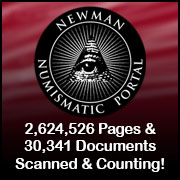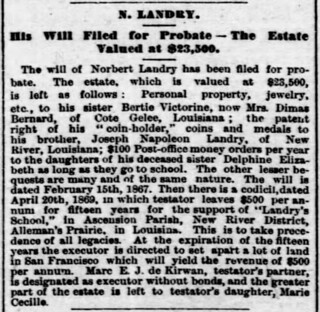
About UsThe Numismatic Bibliomania Society is a non-profit association devoted to the study and enjoyment of numismatic literature. For more information please see our web site at coinbooks.org SubscriptionsThose wishing to become new E-Sylum subscribers (or wishing to Unsubscribe) can go to the following web page link MembershipThere is a membership application available on the web site Membership Application To join, print the application and return it with your check to the address printed on the application. Print/Digital membership is $40 to addresses in the U.S., and $60 elsewhere. A digital-only membership is available for $25. For those without web access, write to: Charles Heck, Treasurer
AsylumFor Asylum mailing address changes and other membership questions, contact Chuck at this email address: treasurer@coinbooks.org SubmissionsTo submit items for publication in The E-Sylum, write to the Editor at this address: whomren@gmail.com BUY THE BOOK BEFORE THE COINSale Calendar |
- WAYNE'S WORDS: THE E-SYLUM MAY 3, 2020
- H. F. BOWKER NUMISMATIC LIBRARY SALE
- NEW BOOK: 2021 HANDBOOK OF U.S. COINS
- NEW BOOK: A TUNE FOR A TOKEN 2ND EDITION
- NEW BOOK: AUSTRO-HUNGARIAN MEDALS
- NEW BOOK: BLUFFING TEXAS STYLE
- BRITISH RARITIES AMONG GREATEST MODERN COINS
- CHINESE WU ZHU COIN VARIETIES SYSTEM OFFERED
- PTOLEMAIC COINS ONLINE UPDATED
- MAY 2020 INTERNATIONAL TOKEN WEB CONFERENCE
- EDWIN LEVENTHAL (1930-2020)
- VIDEO: YELLOW FEVER & THE U.S. MINT
- VIDEO: EAGLES OF THE TYRANT COIN COLLECTION
- NORBERT LANDRY'S COIN ALBUM
- AUCTION HOUSES RAMPING UP ONLINE SALES
- CORONAVIRUS UPDATES: MAY 3, 2020
- CORONAVIRUS COIN SHOWS
- WORLD VS VIRUS COVID-19 TASK FORCE COIN
- PORTLAND SPANISH FLU MEDAL
- ERASED WURTZBACH INSCRIPTION: ARTHUR L. GRAY?
- MORE ON THE 1740 PHILADELPHIA HALFPENCE RIOT
- NOTES FROM E-SYLUM READERS: MAY 3, 2020
- MORE ON THE FORT BRIDGER WYOMING TOKENS
- VOCABULARY TERM: MAHOGANY FINISH
- WILLIAM G. HESSLEIN (1866?-1932?)
- HERITAGE OFFERS DON CHAPMAN U.S. GOLD COLLECTION
- NUMISMAGRAM MEDAL SELECTIONS: MAY 2020
- ARCHIVES INTERNATIONAL SALE #59 SELECTIONS
- CARES ACT TREASURY CHECK SECURITY FEATURES
- BLEEDING INK SECURITY FEATURE
- DIRTY MONEY PILING UP IN L.A.
- LOOSE CHANGE: MAY 3, 2020
- FINALLY THERE'S TIME FOR YOUR BOOKS
- THE LIBRARY OF COIN, IOWA
- FEATURED WEB SITE: SECESSIONIST MEDALS
Click here to access the complete archive
Click here to unsubscribe (scroll down)
To comment or submit articles, reply to whomren@gmail.com
Content presented in The E-Sylum is not necessarily researched or independently fact-checked, and views expressed do not necessarily represent those of the Numismatic Bibliomania Society.
WAYNE'S WORDS: THE E-SYLUM MAY 3, 2020
 New subscribers this week include: Koen Helling, courtesy of A.J. Lansen; Jim Belt, Dan Liberatore, Arthur O'Neill and Jaroslaw Stano. Welcome aboard! We now have
6,116 subscribers.
New subscribers this week include: Koen Helling, courtesy of A.J. Lansen; Jim Belt, Dan Liberatore, Arthur O'Neill and Jaroslaw Stano. Welcome aboard! We now have
6,116 subscribers.
Thank you for reading The E-Sylum. If you enjoy it, please send me the email addresses of friends you think may enjoy it as well and I'll send them a subscription (but let me know if they are located in the European Union). Contact me at whomren@gmail.com anytime regarding your subscription, or questions, comments or suggestions about our content.
This week we open with the Bowker numismatic library sale, four new books, British rarities, Chinese coin varieties, updates from the Newman Numismatic Portal, and a coin album from 1866.
Other topics this week include dealers William Hesslein and JJ Teaparty, Yellow Fever at the U.S. Mint, a Spanish Flu medal, Fort Bridger tokens, mahogany finish medals, medal and paper money offerings, dirty money, and the Coin Library.
To learn more about Chinese banknotes, the Blue Book, orchestrion tokens, Austro-Hungarian orders, medals, and decorations, Ptolemaic coinage, lockdown humor, Wimbledon medals, POW camp scrip, and bleeding ink, read on. Have a great week, everyone!
Wayne Homren
Editor, The E-Sylum
H. F. BOWKER NUMISMATIC LIBRARY SALE
Stephen Album Rare Coins is offering 113 lots from the H. F. Bowker Numismatic Library in their upcoming Auction 37. Howard Franklin Bowker (1889-1970) was a numismatist and philatelist, collecting and specializing in Chinese coins, stamps and banknotes. He created the first bibliography of Western language publications on East Asian numismatics.
Here are some selected lots. -Editor
Lot 3525: Revised Record of Gold and Silver Coins
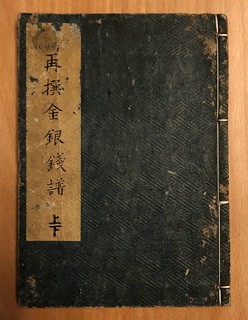 Aoki, Atsushi, Revised Record of Gold and Silver Coins (Saisen kingin senpu), Edo, Meiwa year 7 (1770), 119 pages, yotsume toji (four-eye) binding. With approximately
200 hand-drawn illustrations of gold, silver and bronze coins, ex. H. F. Bowker Numismatic Library. Howard Franklin Bowker (1889-1970) was a numismatist and philatelist,
collecting and specializing in Chinese coins, stamps and banknotes. He created the first bibliography of Western language publications on East Asian numismatics. Nakamura Fusetsu
(1866-1943) was a Japanese painter in the yoga style. He was also known as a calligrapher. Kokotei is another name for Nakamura Fusetsu.
Aoki, Atsushi, Revised Record of Gold and Silver Coins (Saisen kingin senpu), Edo, Meiwa year 7 (1770), 119 pages, yotsume toji (four-eye) binding. With approximately
200 hand-drawn illustrations of gold, silver and bronze coins, ex. H. F. Bowker Numismatic Library. Howard Franklin Bowker (1889-1970) was a numismatist and philatelist,
collecting and specializing in Chinese coins, stamps and banknotes. He created the first bibliography of Western language publications on East Asian numismatics. Nakamura Fusetsu
(1866-1943) was a Japanese painter in the yoga style. He was also known as a calligrapher. Kokotei is another name for Nakamura Fusetsu.
To read the complete lot description, see:
Aoki, Atsushi. Revised Record of Gold and Silver Coins
(Saisen kingin senpu) (https://www.sarc.auction/Aoki-Atsushi-Revised-Record-of-Gold-and-Silver-Coins-Saisen-kingin-senpu_i36700018)
Lot 3629: Hong Wu and Da Zhong Coins
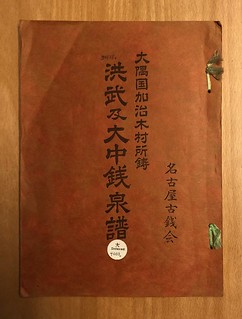 Nagoya Kosenkai, Hong Wu and Da Zhong Coins (Kobu oyobi Taichusen senpu), Nagoya, 1959, 54 pages, softcover with simple string binding. An excellent work on the Kyushu
coins of the Edo period imitating the Ming dynasty Hong Wu and Da Zhong coins and cast by the Shimazu clan between 1573 and 1688, ex. H. F. Bowker Numismatic Library. Howard
Franklin Bowker (1889-1970) was a numismatist and philatelist, collecting and specializing in Chinese coins, stamps and banknotes. He created the first bibliography of Western
language publications on East Asian numismatics. Nakamura Fusetsu (1866-1943) was a Japanese painter in the yoga style. He was also known as a calligrapher. Kokotei is another
name for Nakamura Fusetsu.
Nagoya Kosenkai, Hong Wu and Da Zhong Coins (Kobu oyobi Taichusen senpu), Nagoya, 1959, 54 pages, softcover with simple string binding. An excellent work on the Kyushu
coins of the Edo period imitating the Ming dynasty Hong Wu and Da Zhong coins and cast by the Shimazu clan between 1573 and 1688, ex. H. F. Bowker Numismatic Library. Howard
Franklin Bowker (1889-1970) was a numismatist and philatelist, collecting and specializing in Chinese coins, stamps and banknotes. He created the first bibliography of Western
language publications on East Asian numismatics. Nakamura Fusetsu (1866-1943) was a Japanese painter in the yoga style. He was also known as a calligrapher. Kokotei is another
name for Nakamura Fusetsu.
To read the complete lot description, see:
Nagoya Kosenkai. Hong Wu and Da Zhong Coins (Kobu oyobi
Taichusen senpu) (https://www.sarc.auction/Nagoya-Kosenkai-Hong-Wu-and-Da-Zhong-Coins-Kobu-oyobi-Taichusen-senpu_i36700122)
Lot 3672: Journal of the North China Branch of the Royal Asiatic Society
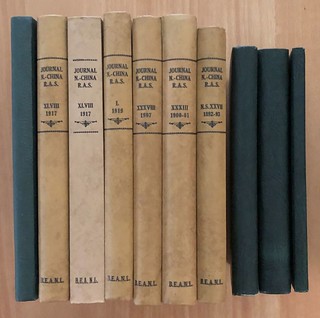 Royal Asiatic Society, Journal of the North China Branch of the Royal Asiatic Society, Shanghai, collection of various volumes including No. XIV 1879, No. XV 1880, No.
XVII Part I 1882, No. XVII Part I 1882, No. XXVII 1892-93, No. XXXIII 1900-01, No. XXXVIII 1907, No. XLVIII 1917 (2 copies), No. L 1919, No. LXXI 1940, group of 10 hardbound
volumes, all with interesting articles on Numismatics with line drawings throughout, English and some Chinese text, lot of 10 volumes, ex. H. F. Bowker Numismatic Library. Howard
Franklin Bowker (1889-1970) was a numismatist and philatelist, collecting and specializing in Chinese coins, stamps and banknotes. He created the first bibliography of Western
language publications on East Asian numismatics.
Royal Asiatic Society, Journal of the North China Branch of the Royal Asiatic Society, Shanghai, collection of various volumes including No. XIV 1879, No. XV 1880, No.
XVII Part I 1882, No. XVII Part I 1882, No. XXVII 1892-93, No. XXXIII 1900-01, No. XXXVIII 1907, No. XLVIII 1917 (2 copies), No. L 1919, No. LXXI 1940, group of 10 hardbound
volumes, all with interesting articles on Numismatics with line drawings throughout, English and some Chinese text, lot of 10 volumes, ex. H. F. Bowker Numismatic Library. Howard
Franklin Bowker (1889-1970) was a numismatist and philatelist, collecting and specializing in Chinese coins, stamps and banknotes. He created the first bibliography of Western
language publications on East Asian numismatics.
To read the complete lot description, see:
Royal Asiatic Society. Journal of the North China
Branch of the Royal Asiatic Society (https://www.sarc.auction/Royal-Asiatic-Society-Journal-of-the-North-China-Branch-of-the-Royal-Asiatic-Society_i36700165)
Lot 3708: Chinese Banknotes
 Smith, Ward D. & Brian Matravers, Chinese Banknotes, Shirjeh Publishers, Menlo Park, California, 1970, 225 pages, photos throughout, hardcover, English text with
bank names in Chinese characters. An extensive alphabetical catalogue of Chinese banknotes with explanations of all the issuing entities, multiple appendices and indices. Most
notes illustrated. Much more detailed than Pick. Best one-volume work on Chinese paper and still much referenced, ex. H. F. Bowker Numismatic Library. Howard Franklin Bowker
(1889-1970) was a numismatist and philatelist, collecting and specializing in Chinese coins, stamps and banknotes. He created the first bibliography of Western language
publications on East Asian numismatics.
Smith, Ward D. & Brian Matravers, Chinese Banknotes, Shirjeh Publishers, Menlo Park, California, 1970, 225 pages, photos throughout, hardcover, English text with
bank names in Chinese characters. An extensive alphabetical catalogue of Chinese banknotes with explanations of all the issuing entities, multiple appendices and indices. Most
notes illustrated. Much more detailed than Pick. Best one-volume work on Chinese paper and still much referenced, ex. H. F. Bowker Numismatic Library. Howard Franklin Bowker
(1889-1970) was a numismatist and philatelist, collecting and specializing in Chinese coins, stamps and banknotes. He created the first bibliography of Western language
publications on East Asian numismatics.
To read the complete lot description, see:
Smith, Ward D. & Brian Matravers. Chinese Banknotes
(https://www.sarc.auction/Smith-Ward-D-Brian-Matravers-Chinese-Banknotes_i36700201)
Lot 3737: Bowker Archive
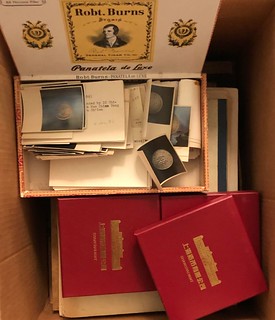 Various, LOT of personal papers, coin photos, articles, file folders a wide range of topics, plus 3 large 2010 Shanghai bronze medal honoring H. K. Bowker struck at the
Shanghai mint with boxes and COAs, viewing recommended, large box of items, ex. H. F. Bowker Numismatic Library. Howard Franklin Bowker (1889-1970) was a numismatist and
philatelist, collecting and specializing in Chinese coins, stamps and banknotes. He created the first bibliography of Western language publications on East Asian numismatics.
Various, LOT of personal papers, coin photos, articles, file folders a wide range of topics, plus 3 large 2010 Shanghai bronze medal honoring H. K. Bowker struck at the
Shanghai mint with boxes and COAs, viewing recommended, large box of items, ex. H. F. Bowker Numismatic Library. Howard Franklin Bowker (1889-1970) was a numismatist and
philatelist, collecting and specializing in Chinese coins, stamps and banknotes. He created the first bibliography of Western language publications on East Asian numismatics.
To read the complete lot description, see:
3737 Various (https://www.sarc.auction/Various_i36700230)
For more background on Bowker, here's an excerpt from his Wikipedia entry. -Editor
Howard Bowker was born on 3 January 1889 in Winona, Minnesota, the third of seven children. After graduating from the Crane High School (Chicago) in 1903, at the age of fourteen, he went to work at the Peoples Gas Light and Coke Company to help support the family.
He joined the navy in October 1912, and served for 34 years, including both World War I and World War II, mostly in administration, usually associated with payroll.
By 1910 Bowker was a self-proclaimed, self-employed coin dealer in the Chicago area. He became interested in Chinese coins while stationed in Hankow (1923-1924). He visited collections at the Smithsonian Institution, the American Numismatic Society, the University of Pennsylvania, and was an active member of the Numismatic Society of China, the Pacific Coast Numismatic Society, the American Numismatic Society, and the American Numismatic Association. His service with the Navy enabled him to collect both in the USA and overseas, and to meet with collectors (e.g. Kalgan Shih, Eduard Kann). He curated a large exhibition of Chinese numismatic material at the California State Numismatic Society's show in Santa Rosa in 1951 (featuring pieces from his collection, the A.G. Adams collection, pieces borrowed from A.B. Coole and other collectors). In the mid-1950s he provided consulting services to the Smithsonian Institution, a position that became official in 1958.
To read the complete Wikipedia article, see:
Howard Franklin Bowker (https://en.wikipedia.org/wiki/Howard_Franklin_Bowker)
To view the Bowker lots in the Album Auction 37, see:
Stephen Album Rare Coins | Auction
37 (https://www.sarc.auction/Stephen-Album-Rare-Coins-Auction-37_a42584?m=all&p=1&ps=50&so=1&q=bowker&hi=0&vm=0)
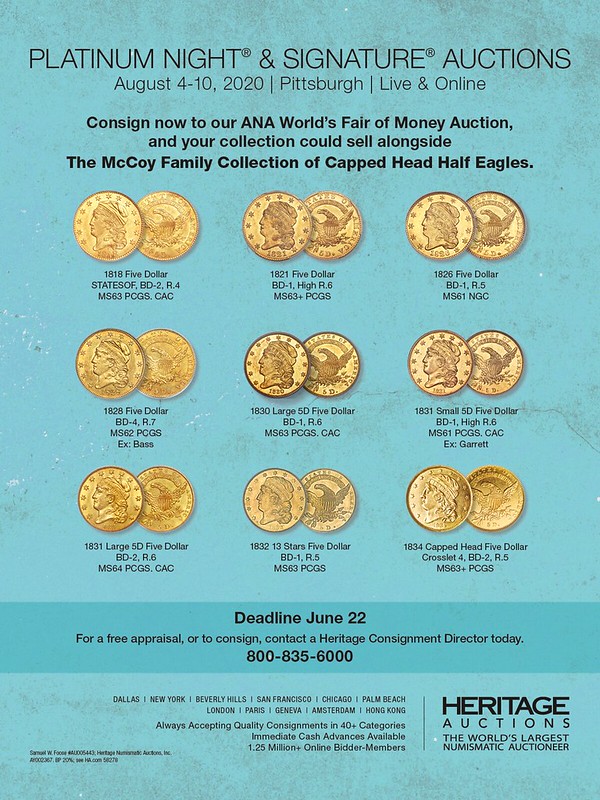
NEW BOOK: 2021 HANDBOOK OF U.S. COINS
Whitman Publishing has announced the 2021 edition of the Blue Book. -Editor
Coin Collectors Get a Fresh Dose of the Blues
The Best-Selling Blue Book Tells How Much Your Coins Are Worth
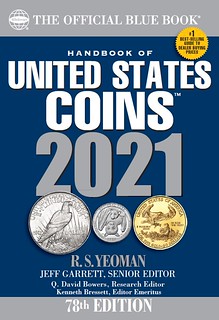 Of all the numismatic books Whitman Publishing has created over the years, including many recent titles that have already matured into standard references, the Guide
Book of United States Coins—the "Red Book"—is by far the most popular. It's hard to argue popularity when generations of coin collectors have bought more than 24 million copies in
total!
Of all the numismatic books Whitman Publishing has created over the years, including many recent titles that have already matured into standard references, the Guide
Book of United States Coins—the "Red Book"—is by far the most popular. It's hard to argue popularity when generations of coin collectors have bought more than 24 million copies in
total!
The hobby community has another long-running annual price guide, though: one that deserves at least a tiara if not the record-holder's crown. The Handbook of United States Coins—the wholesale-price guide known in the hobby as the "Blue Book"—has actually been on the numismatic scene longer than its retail-pricing counterpart. Hobby legend R.S. Yeoman started the book in 1942 as a groundbreaking resource for coin collectors. (It wasn't until 1946 that the Red Book would come into being.) With the Blue Book, for the first time ever hobbyists had an impartial, research-driven annual guide to tell them how much the typical dealer would pay for their U.S. coins, and dealers had a handy guide for buying.
What Exactly Is the Blue Book?
Today, Senior Editor Jeff Garrett, backed up by Research Editor Q. David Bowers (with an annual overview by Editor Emeritus Kenneth Bressett), continues the venerable Yeoman tradition. As the Blue Book nears its eightieth anniversary, collectors and dealers alike find it to be a valuable yearly indicator for wholesale coin values. More than 100 leading professional coin dealers, numismatic researchers, and organizations contributed to the 78th edition, which is available now from bookstores and numismatic dealers around the nation.
New coin collectors sometimes ask, "What's the difference between the Blue Book and the Red Book?" The main answer is simple: the Blue Book lists wholesale prices many coin dealers will pay for collector coins; the Red Book lists retail prices that a collector can expect to pay for the same coins.
For the past 78 years, the Blue Book has aided millions of people who have inherited coin collections, have coins to sell or trade, or are actively engaged in collecting. The popular coin-folder method of collecting by date and mintmark has created ever-changing premium values for coins, based on the supply and demand of each. The Blue Book, through its panel of contributors, has reported these changing values over the years. It also serves as a source of general numismatic information for all levels of interest in the hobby.
Who Uses the Blue Book?
Many Blue Book readers are longtime numismatists who appreciate the quality of the book's photographs and historical/technical data. Other readers might not actively collect coins, but found some old "pennies" and nickels in Grandpa's cigar box in the basement and want to know how much they're worth. In addition to more than 25,000 listed dealer buy prices, the Blue Book contains a wealth of numismatic information—instructions on grading, more than 900 photographs that can be used to identify coins, rare and valuable features to look for, mintages and other data, historical background, and more. The book has sections on colonial and early American pieces, all regular federal coins from the 1790s to date, classic and modern commemoratives, Proof and Mint sets, popular die varieties, private and territorial gold, bullion, State quarters, Presidential dollars, selected American tokens and medals dating from the 1600s onward, and more.
"More people than ever are inheriting coin collections," said Garrett, "and the Blue Book is an excellent tool to start the process of establishing values. The book is simple to understand, with accurate pricing reflecting what you can expect to receive for your coins."
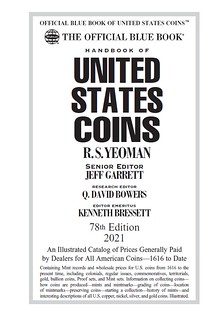
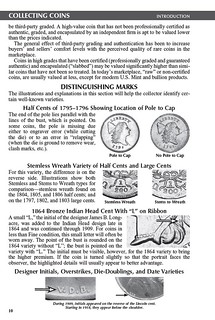
How are the Blue Book's Prices Compiled?
The values shown inside the Blue Book are average prices paid by dealers for various United States coins. They represent a cross-section of prices being paid around the country, compiled from many geographically separated sources, from coast to coast and North to South, some in heavily populated metropolitan centers and some in smaller towns. All are experienced professional coin dealers or longtime collector specialists. Local supply and demand and unique inventory conditions can affect any given dealer's pricing; having a single-source compilation of typical prices gives both buyers and sellers a benchmark for comparison. While many coins bring no premium in circulated grades (e.g., common pocket change), they usually bring higher prices in Mint State and Proof. Extremely rare and valuable coins are often sold at public auction, and prices vary according to current supply and demand.
Editor Emeritus Kenneth Bressett recalls his experience with the Blue Book, first as a reader and later as its editor: "The Blue Book was the first professionally produced coin reference that I ever used. When it was introduced in 1942 I was astounded by the scope and quality of its content. I continue to use it today as a handy reference to market trends, and as a quick way to find reliable statistical data that it contains. Throughout the years, Whitman has continued to uphold the standards set by its original author, R.S. Yeoman, and to provide collectors with the best and most accurate information possible. I am often reminded of how fortunate I was to have found a copy of this important book so early in my career, and to have been a part of continuing the tradition for the past 78 years."
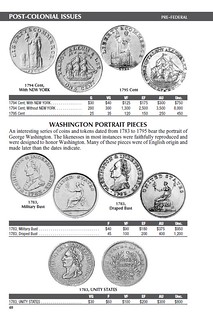

New Features in This Year's Blue Book
The 78th edition of the Blue Book (with a 2021 cover date) features the modern, updated layout of recent years, improved black-and-white photographs, the latest data from the United States Mint, and, for the first time ever, a 16-page full-color feature section on Morgan and Peace silver dollars. "The dual 100th anniversary of the last Morgan dollar and the first Peace dollar is approaching in 2021," said Whitman publisher Dennis Tucker. "This year's Blue Book explores the history and charm of these valuable silver coins, two of America's favorite classics."
All of this combines to make the Blue Book a handy educational reference—and explains why, like the Red Book, it remains one of the longest-selling publications in the hobby.
Published in convenient softcover and library-quality hardcover on high-quality paper, the 78th (2021) edition Blue Book has a retail price of $12.95 (softcover) or $14.95 (hardcover). You will find it online, and at bookstores and hobby shops and retailers nationwide.


Handbook of United States Coins (The Official Blue Bookâ„¢), 78th edition
Edited by Jeff Garrett, Q. David Bowers, and Kenneth Bressett.
Softcover (ISBN 0794848052), $12.95
Hardcover (ISBN 0794848044), $14.95
304 pages
Full color

NEW BOOK: A TUNE FOR A TOKEN 2ND EDITION
Regarding a new TAMS Journal Supplement, Bill Hyder of the Token and Medal Society writes: "Thanks to donations from Q. David Bowers and Ken Goldman, Dave's new book A Tune for a Token, Second Edition is being distributed to TAMS members as a
benefit of their membership. I donated my time in designing, producing, and mailing the book. Mailing started on April 20 and will continue for another 5 to 6 weeks.
"Thanks to donations from Q. David Bowers and Ken Goldman, Dave's new book A Tune for a Token, Second Edition is being distributed to TAMS members as a
benefit of their membership. I donated my time in designing, producing, and mailing the book. Mailing started on April 20 and will continue for another 5 to 6 weeks.
Owing to staffing shortages at our local post office and my desire to not be the cause of building up a line of others waiting for postal services, I am mailing one or two cases a day (14 to 28 books a day). If TAMS members are patient, their book will arrive sometime by the end of June.
The good news for non-TAMS members, if you join in the next few months you will receive a copy of the book while supplies last."
What a huge benefit for TAMS membership! See below for the link to their site. Here's an excerpt from the book's Introduction by Dave Bowers. -Editor
Welcome to the second edition of A Tune for a Token. The first edition published by the Token and Medal Society won the Publication of the Year Award. The second builds on the first and adds many new things.
The main reason for creating this book in 1975 and updating it now is because I like the thrill of the hunt, to explore the obscure and sometimes unknown. Few specialties are as obscure as these music tokens! I have taken a number of other numismatic byways in my life. My book, The Strange Career of Dr. Wilkins, about a dentist who in the 1850s and 1860s counterstamped hundreds of cents with his name as an advertisement, was fun to research and write and, believe it or not, was well received and sold out. Numismatists seem to like interesting stories. Wilkins was a character deluxe. He also had a restaurant and kept a caged bear in front. He was accused of counterfeiting and also burning down a barn of someone who had crossed his path. Along the same line my Waterford Water Cure book explored the counterstamped coins issued by Dr. Shattuck who operated a clinic or retreat in Waterford, Maine in the 19th century, when the water cure treatment was popular nationwide and was said to cure just about any malady known to mankind. That book also sold out, and John J. Ford, Jr. said it was his favorite of the books I have written over the years.
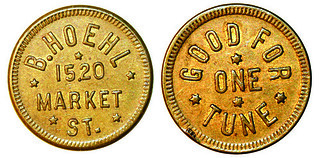 In the 1960s and 1970s I and others did numismatic research the hard way: by visiting libraries and filling out call slips, by paging through old city directories, by
correspondence with other collectors, and other activities—all very pleasurable, but very time-consuming. Today the Internet beckons, and on line I can tap into city directories,
town histories, legal actions, and more. Many Good for One Tune tokens have partial information—such as the name of a saloon, but no location, or a street address but no business
or city name. Searching on the Internet has enabled me to identify many tokens that were mysterious years ago. Enough questions remain that you as a reader of this book might find
more information to add.
In the 1960s and 1970s I and others did numismatic research the hard way: by visiting libraries and filling out call slips, by paging through old city directories, by
correspondence with other collectors, and other activities—all very pleasurable, but very time-consuming. Today the Internet beckons, and on line I can tap into city directories,
town histories, legal actions, and more. Many Good for One Tune tokens have partial information—such as the name of a saloon, but no location, or a street address but no business
or city name. Searching on the Internet has enabled me to identify many tokens that were mysterious years ago. Enough questions remain that you as a reader of this book might find
more information to add.
Tokens described in this book have many different inscriptions, some describing coin-operated pianos and orchestrions in various locations from The Bowery in New York City to out West in the Cliff House near the entrance to San Francisco Bay. I love the Cliff House and its traditions and have visited the site many times—the new Cliff House built in the early 20th century and the adjacent Sutro Baths amusement facility, not to overlook the nearby Playland at the Beach. From the Whitney family, owners in the 1960s of all three of these establishments, I purchased many coin-operated instruments that had been left over from the "good old days." In this book you will read about the Cliff House and a token once used there. To me if the history is known about a token, medal, coin, or bank note, my interest in it multiplies.
Because of this, when the location of a token can be identified I try to learn about the establishment that issued it. In this book you will read about many such places. One token can lead to enough fascinating information that I could create an article on it for the Token and Medal Society Journal. In the past for the TAMS Journal, The Civil War Token Journal, The Numismatist, Coin World, and other periodicals I have written many articles on interesting varieties of tokens, medals, paper money, and other obscure subjects.
David Schenkman, who consented to write the foreword to this book, has done the same over a long period of years. His contributions to the present text were immense and added much to the listings. He has dealt in various store cards and related tokens since 1960 and supplied most of the rarity and price estimates. A list of his articles on other types of tokens would fill several pages.
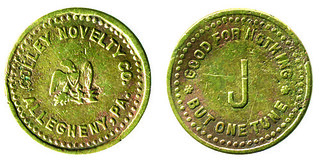 I must add that for just about anyone research of this type across many specialties adds up to making numismatics a part of your life. If you read the names of
contributors to journals of the various specialized societies you will find people that have been in the field for 10, 20, or more years. The art, science, history, and romance of
numismatics are elements of a wonderful field. In contrast, anyone entering numismatics hoping to make a quick profit but finds that within a year or two nothing has happened
usually leaves coin collecting forever. Speaking of profit, there is a secret that is not a secret to long-time insiders: a fine collection of tokens carefully formed and held
over a period of years has always returned a profit when sold. I know of no exceptions.
I must add that for just about anyone research of this type across many specialties adds up to making numismatics a part of your life. If you read the names of
contributors to journals of the various specialized societies you will find people that have been in the field for 10, 20, or more years. The art, science, history, and romance of
numismatics are elements of a wonderful field. In contrast, anyone entering numismatics hoping to make a quick profit but finds that within a year or two nothing has happened
usually leaves coin collecting forever. Speaking of profit, there is a secret that is not a secret to long-time insiders: a fine collection of tokens carefully formed and held
over a period of years has always returned a profit when sold. I know of no exceptions.
I also give a nod to Bill Hyder of the Token and Medal Society who shepherded my book on shell cards through to publication and will be doing the same with this. Among my new friends gained in recent research is Julia H. Casey, who more than any other contributor to the present book tracked down and in many instances furnished information about tokens that would otherwise be listed in appendix 2 (named tokens from unknown locations). John Byars has been a close second in research discoveries. Both have tracked down information that has eluded me for decades.
And here's an excerpt from the book's Foreword by David Schenkman. -Editor
In 1975 the Token and Medal Society published Dave Bowers' catalog, A Tune for a Token, and I remember being immediately fascinated by the many different tokens he listed. Dave didn't merely compile a catalog; he also discussed automatic musical instruments, and the tokens themselves. I immediately started collecting tune tokens!
One of the things collectors new to the hobby learn early on is the fact that tokens are not easy to find. So, even if cost is not a consideration, building a collection takes time and persistence. Without exception, every one of the tokens cataloged herein is many times rarer than United States coins such as the 1916-D dime and 1877 Indian cent, and most of them are even rarer than the famous 1804 silver dollar. The corollary is that for the price of a Mint State 1916-D dime, of which many hundreds are known, with a lot of patience you can form one of the best tune tokens ever! In contrast, if you want a Mint State 1916-D dime you can buy one on the Internet this afternoon.
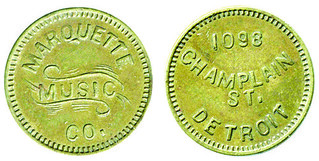 Books such as this are never complete. In his 1975 work, Dave cataloged approximately 190 tokens and commented "I believe that the present listing is just the tip of the
iceberg and that many more varieties remain to be discovered." How right he was; the book you are holding more than three times that number, and this is even more impressive in
view of the fact that the original catalog listed advertising tokens, issued by companies that sold player pianos; they are not included in this edition. Undoubtedly even more
varieties are awaiting discovery, and the thrill of finding a previously unknown token is an enjoyable part of the collecting experience. This will happen to you.
Books such as this are never complete. In his 1975 work, Dave cataloged approximately 190 tokens and commented "I believe that the present listing is just the tip of the
iceberg and that many more varieties remain to be discovered." How right he was; the book you are holding more than three times that number, and this is even more impressive in
view of the fact that the original catalog listed advertising tokens, issued by companies that sold player pianos; they are not included in this edition. Undoubtedly even more
varieties are awaiting discovery, and the thrill of finding a previously unknown token is an enjoyable part of the collecting experience. This will happen to you.
If you are just starting to read this book, you are in for a real treat. You'll soon learn that it is much more than just a catalog. Dave has a wonderful way of weaving history and numismatics, and you will find yourself as engrossed in the life and times of the late nineteenth and early twentieth centuries as I was when I read it. In the process you'll learn a lot about tokens and who knows; you just might find yourself as addicted to collecting tune tokens as I was after reading Dave's 1975 study.
For more information on the Token and Medal Society, see:
http://www.tokenandmedal.org/

NEW BOOK: AUSTRO-HUNGARIAN MEDALS
The latest addition to the Newman Numismatic Portal is a new book on Austro-Hungarian Orders, Medals and Decorations. Project Coordinator Len Augsburger provided the following report. -Editor
Richard R. Lussier Publishes Austro-Hungarian Orders, Medals and Decorations
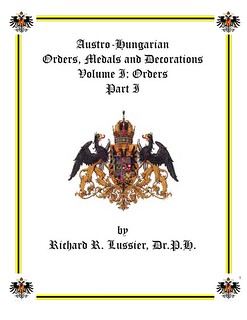 Recently added to Newman Portal is Richard Lussier's massive compendium detailing Austro-Hungarian orders, medals, and decorations. The work is divided into multiple
volumes, beginning with awards and proceeding through decorations, medals, and semi-official issues. Lussier further dedicates a volume to the craftspeople, covering jewelers,
manufacturers, and hallmarks of those involved with the creation of these pieces. Lussier worked extensively with Austrian archives and many other sources over a period of forty
years, and it is fair to describe this effort as his numismatic life's work.
Recently added to Newman Portal is Richard Lussier's massive compendium detailing Austro-Hungarian orders, medals, and decorations. The work is divided into multiple
volumes, beginning with awards and proceeding through decorations, medals, and semi-official issues. Lussier further dedicates a volume to the craftspeople, covering jewelers,
manufacturers, and hallmarks of those involved with the creation of these pieces. Lussier worked extensively with Austrian archives and many other sources over a period of forty
years, and it is fair to describe this effort as his numismatic life's work.
Lussier has previously published articles drawn from this work through the Orders and Medal Society of America, and contributed blog entries to their website. Totaling 1,669 pages and containing thousands of images, this will serve as the standard reference for the foreseeable future.
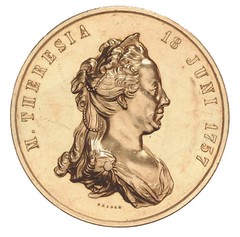
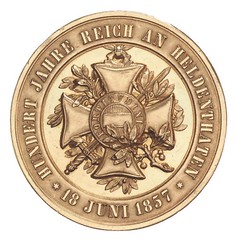
Image: Maria Theresien 100 year Jubilee medal (1857), cataloged in volume 7 (Table Medals), part 1.
Link to Austro-Hungarian Orders, Medals and Decorations on Newman Portal:
https://nnp.wustl.edu/library/booksbyauthor/537591
Link to Orders and Medals Society of America:
https://www.omsa.org/
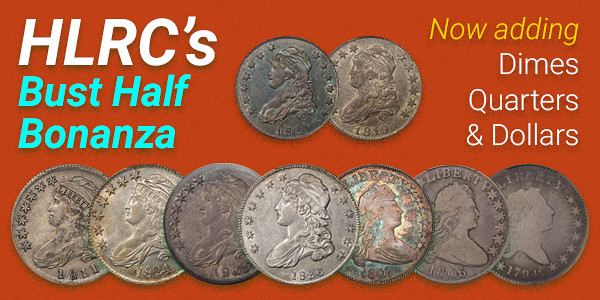
NEW BOOK: BLUFFING TEXAS STYLE
This one has no numismatic connection I'm aware of, but bibliophiles may find it of interest. The story also has parallel with Utah forger counterfeiter and murderer Mark Hofmann, who created and sold nearly perfect copies of Mormon currency and documents. -Editor
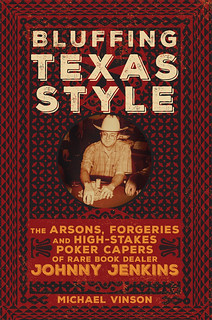 As the extended subtitle of Michael Vinson's book says, Johnny Jenkins (1940-1989) was an arsonist, a forger, a rare-book dealer and a high-stakes poker player who
clomped around in cowboy boots and a Stetson while shuttling back and forth between Las Vegas and Austin, Texas. Jenkins was that irresistible type—a Wild West con man you
couldn't help but like and almost admire while he was cheating you. He even, it seems, tried to cheat death by committing suicide in such a way that it would be taken for murder.
Suicide would have shown weakness and deflated the legend of himself that Jenkins worked all his life to create. On the other hand, murder was a suitable, even inevitable end for
the frontier gambler Johnny Jenkins portrayed himself as being. RIP.
As the extended subtitle of Michael Vinson's book says, Johnny Jenkins (1940-1989) was an arsonist, a forger, a rare-book dealer and a high-stakes poker player who
clomped around in cowboy boots and a Stetson while shuttling back and forth between Las Vegas and Austin, Texas. Jenkins was that irresistible type—a Wild West con man you
couldn't help but like and almost admire while he was cheating you. He even, it seems, tried to cheat death by committing suicide in such a way that it would be taken for murder.
Suicide would have shown weakness and deflated the legend of himself that Jenkins worked all his life to create. On the other hand, murder was a suitable, even inevitable end for
the frontier gambler Johnny Jenkins portrayed himself as being. RIP.
Jenkins left his papers to the DeGolyer Library at Southern Methodist University in Dallas, and Mr. Vinson spent weeks there turning over every page. He also interviewed widely among the many booksellers, gamblers, collectors and academics who had dealings with Jenkins over the years.
Mr. Vinson has solved the long-standing mystery of Johnny Jenkins. His research shows that, beginning with his college days, there was never a time when Jenkins was not cheating, swindling, stealing and lying. In particular, Mr. Vinson has discovered stubs from the two checks that Jenkins used to buy the printing plates he then used to print forgeries of rare Texas documents from the time of the Texas Revolution. Jenkins had always denied that he owned these plates, but the forgeries he created with them were by far his cleverest and most lucrative swindle.
Jenkins, despite his denials, surely felt things closing in on him in early 1989. Besides the local news reports about the forgeries, there was also suspicion surrounding two fires in his warehouses during the previous five years, and it looked like Jenkins would soon be indicted on a charge of arson. He was delinquent on his federal taxes. Meanwhile, at just the wrong time, he had apparently lost interest in running his book business. Instead he was spending weeks at a time in Las Vegas playing in poker tournaments and side games where he occasionally won a little but more frequently lost a lot. He owed at least $1 million to creditors all over Las Vegas.
Although "Bluffing Texas Style" is an indictment of Jenkins, I think he might have been secretly proud that his exploits inspired this readable and solidly researched book.
To read the complete article (subscription required), see:
‘Bluffing Texas Style' Review: Forgeries and Fires
(https://www.wsj.com/articles/bluffing-texas-style-review-forgeries-and-fires-11588113171)
For more information, or to order, see:
Bluffing Texas Style The Arsons, Forgeries, and High-Stakes Poker Capers of Rare Book Dealer Johnny Jenkins
(https://oupress.com/books/15452018/bluffing-texas-style)
To read a 1987 New York Times article on Hofmann, see:
DEALER IN MORMON FRAUD CALLED A MASTER FORGER
(https://www.nytimes.com/1987/02/11/us/dealer-in-mormon-fraud-called-a-master-forger.html)
To read an earlier E-Sylum article, see:
MORE ON THE FORGERIES OF MARK HOFMANN (https://www.coinbooks.org/v21/esylum_v21n01a11.html)
BRITISH RARITIES AMONG GREATEST MODERN COINS
Dennis Tucker of Whitman Publishing submitted this article about British rarities in the 100 Greatest Modern World Coins book. Thanks. -Editor
British Rarities Among Greatest Modern Coins
by Dennis Tucker
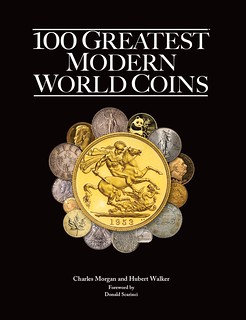 Numismatic Guaranty Corporation announced in April 2020 that its London affiliate, NGC UK, has certified a 1952 British penny. If an American collector focuses only on
U.S. coins and doesn't study money from across the Pond, this might seem like a strange thing to publicize. The United States Mint produced more than a billion Wheat cents in
1952. Surely Britain's pennies were minted by the millions, too?
Numismatic Guaranty Corporation announced in April 2020 that its London affiliate, NGC UK, has certified a 1952 British penny. If an American collector focuses only on
U.S. coins and doesn't study money from across the Pond, this might seem like a strange thing to publicize. The United States Mint produced more than a billion Wheat cents in
1952. Surely Britain's pennies were minted by the millions, too?
In fact, they weren't. And the 1952 penny deserves every headline it's earned.
NGC describes the coin as "a numismatic unicorn." It's unique—and not in the rhetorical sense that promoters sometimes throw around to describe coins that are merely interesting, super-rare, and valuable.
This one-of-a-kind coin is truly one of a kind. No other 1952 penny is known to exist.
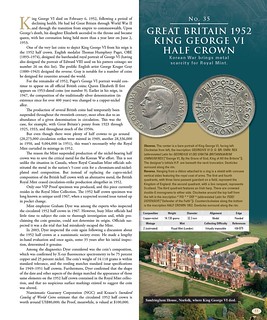 The bronze coin features a profile of King George VI, who died in 1952. His Majesty's likeness on British coinage would be replaced in 1953 by a fresh-faced portrait of
his young daughter, Princess Elizabeth. With his passing she became Queen Elizabeth II.
The bronze coin features a profile of King George VI, who died in 1952. His Majesty's likeness on British coinage would be replaced in 1953 by a fresh-faced portrait of
his young daughter, Princess Elizabeth. With his passing she became Queen Elizabeth II.
The reason Britain didn't mint pennies in 1952 was not because of the transition between monarchs, but because there were already enough such coins in the channels of commerce.
Numismatists Charles Morgan and Hubert Walker, writing in their new book, 100 Greatest Modern World Coins (Whitman Publishing, 2020), discuss the situation: "The production of several British coins had temporarily been suspended throughout the twentieth century, most often due to an abundance of a given denomination in circulation. This was the case, for example, with Great Britain's penny from 1923 through 1925, 1933, and throughout much of the 1950s."
Another British coin from 1952, the King George VI half crown, ranks as no. 35 among Morgan and Walker's 100 Greatest. Only two examples are known to exist: One is the VIP Proof specimen currently residing in the Royal Mint Collection. That particular coin was thought to be unique until 1967, when a second example turned up—in pocket change! Examination by Royal Mint employees and other experts led the Mint to proclaim it genuine, although its precise origins remain unknown. According to Morgan and Walker, "Officials suspected it was a die trial that had mistakenly escaped the Mint."
Unlike the case of the bronze 1952 penny, which was suspended because enough coins of that denomination were already in circulation, the Royal Mint held off making the copper-nickel 1952 half crown in order to save metal for military production. The Korean War was on, and nickel was mission-critical for ordnance and other equipage.
The story of these coins is just one of many among the 100 Greatest. In their beautifully illustrated book, award-winning writers Morgan and Walker offer a guided tour of coins that have influenced the world and captured the imaginations of collectors since the early 1900s. In defining "greatness," their exploration focuses on such factors as rarity, value, popularity, beauty, innovation, and historical significance.
There are a half dozen other entries from Great Britain among the 100 Greatest Modern World Coins. They include a silver trade dollar, two pennies, a gold sovereign, and two Proof sets. Only China ranks higher that Great Britain with more coins among the 100 Greatest, although there are also many British imperial and Commonwealth entries, including coins from Australia, Canada, East Africa, India, New Zealand, the British Mandate of Palestine, and South Africa.
100 Greatest Modern World Coins can be ordered online (including at Whitman.com) and from booksellers and hobby shops nationwide.
100 Greatest Modern World Coins
By Charles Morgan and Hubert Walker; foreword by Donald Scarinci
ISBN 0794846335
Hardcover, coffee-table (10 x 12 inches)
168 pages; full color
Retail $29.95 U.S.
To read the earlier E-Sylum articles, see:
NEW BOOK: 100 GREATEST MODERN WORLD COINS (https://www.coinbooks.org/v22/esylum_v22n52a02.html)
THE UNIQUE 1952 GEORGE VI PROOF PENNY (https://www.coinbooks.org/v23/esylum_v23n16a24.html)
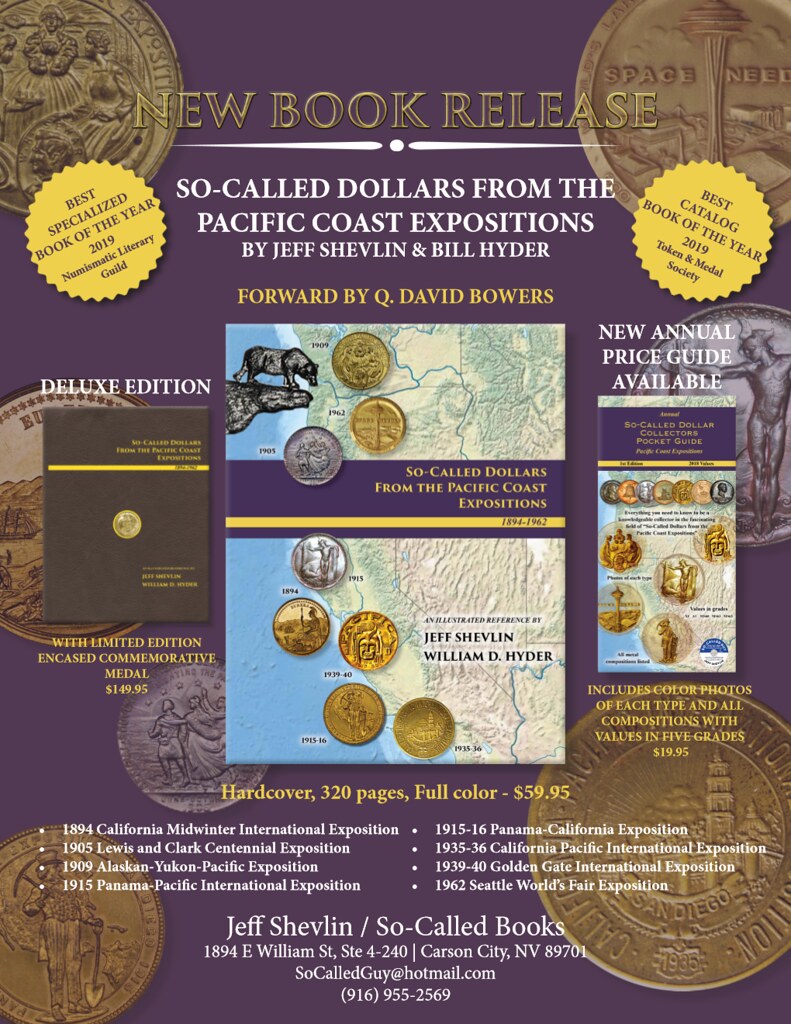
CHINESE WU ZHU COIN VARIETIES SYSTEM OFFERED
Ted Puls writes:
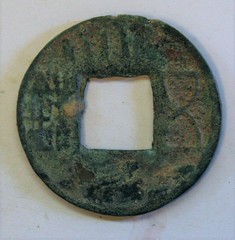 "I have been working on a system for organizing "graffiti" on ancient Chinese wu zhu coins. The approximately 5500 word written description is done. I
would be willing to share this if someone one on your list would be interested.
"I have been working on a system for organizing "graffiti" on ancient Chinese wu zhu coins. The approximately 5500 word written description is done. I
would be willing to share this if someone one on your list would be interested.
"But, as my loving daughter tells, me- nobody else on the planet is interested. (I have to work on checking that the actual varieties in the spreadsheet list are correct. This may take me some time as the spreadsheet has well over 700 varieties). This could be made available someday, as well as pictures of all of them- already done."
OK, let's prove that statement wrong. I'm sure there will be some interest in this great work. Ted can be reached at tedkate@comcast.net .
Here's an excerpt from the manuscript. -Editor
From the beginning of the Silk Road, the Chinese cast Wu Zhu coins as the primary money for most of the people on earth. The "militant" Emperor Wu of the Han Dynasty changed the previous long-lived coinage called the Pan Liang ("half ounce") into his coinage called the Wu Zhu ("five grains") in 118 B.C. This coinage was to be the preferred money until the founding of the Tang dynasty ca. 600 A.D. These coins circulate much longer. Some were recently found in a Liao Dynasty site dated 400 years later. The British found them circulating during the last imperial dynasty in the 19th century. They were copied for trade along the Silk Road using metals available to local mints. These were sometimes close to the originals and sometimes were made in distinctive types with a mix of the Chinese writing and the local Kotan writing on the same coin. The Official coinage was often very nicely cast but also degraded when the economy required debasement.
During the later times called the Eastern Han the quality dropped significantly with the power of the emperor. After the fall of the dynasty a remarkable coinage of Wu Zhu were cast in amazingly small and light weight sizes by the temporarily successful general who defeated the Han. After this time of trial, a myriad of dynasties and kingdoms came and went often reviving the coinage somewhat. Wu Zhu were cast for at least 400 more years during these turbulent times.
During the late Han Dynasty, the various mints began the curious practice of using varied marks in addition to the wu and zhu characters on the coinage. These marks were sometimes placed in the mold to result in a raised character and the marks were sometimes engraved into the surface after casting. The purpose of these marks is unknown at this writing. This unknown is one attraction of collecting these mysterious artifacts. I have not seen a satisfactory way of organizing these myriad marks to allow a start to classifying and of understanding them so this is my attempt. The number of marks or symbols is limited but the many ways they were used and combined in a vast quantity of types that calls for a system of organizing them.
 The most common mark is a plain dot. These Chinese minters were able to derive many varieties out of this simple mark. To begin I suspect that the mint organized marks
using a traditional ideal of the farm layout using the 9-field system to divide land in a community in a pattern like a tic-tac-toe game. The center square field is the coin's
square hole. Above and below this central hole are two common areas to place marks. Dots were arranged in 3 fields above and below the field containing the wu and zhu characters
and in the field containing the characters. Dots were also placed on the reverse of the coins.
The most common mark is a plain dot. These Chinese minters were able to derive many varieties out of this simple mark. To begin I suspect that the mint organized marks
using a traditional ideal of the farm layout using the 9-field system to divide land in a community in a pattern like a tic-tac-toe game. The center square field is the coin's
square hole. Above and below this central hole are two common areas to place marks. Dots were arranged in 3 fields above and below the field containing the wu and zhu characters
and in the field containing the characters. Dots were also placed on the reverse of the coins.
This simple start is made more complicated by additional options in dot placement. The "dot above the hole" varieties seem to have dots placed near the inner hole, in the middle of the field, and also need the outer edge (low, medium and high placement). The dot on the hole was sometimes a half dot. If this wasn't enough the dot also could be placed not only centrally, but also to the right and the left of the middle of this "field". The total number of possible dot positions above the hole is nine. Below the hole the same numbers of possible spots can be seen. Spots for dots also were displayed in the fields above and below the wu and zhu characters. Zhu will have a similar set of options for dot placements.
I haven't discerned the vertical low medium and high positioned dots in these fields. This suggests that three positions for dots exist in the fields above each character but also three more each for fields below these two characters. The wu containing field on the right of the hole has its own set of dot placements. Wu can have a dot in the middle of the character where the lines cross. Inside the hourglass like figure of wu, regular dots were placed in the upper space, the lower space, and sometimes a dot was placed in the upper and lower space. Triangular dots are found inside the hour glass also, which seem to be a distinctive design. Less commonly dots were places beside the waist of the Wu character toward the inner rim or on the outer rim side. Zhu dots are less clear. Some feel that raised area on the character are intentional dots rather than casting flaws. I haven't seen these dots repeated on two coins and believe they are casting errors.
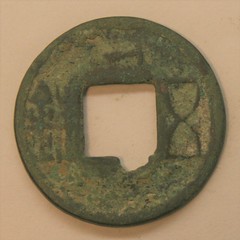
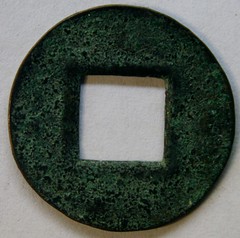
Far more than dots are involved - there are half-dots, vertical and diagonal bars, raised and incuse carving, numerals, words and even subtle variations of mark size, shape and location. Again, Ted can be reached at tedkate@comcast.net for more infomration. -Editor

PTOLEMAIC COINS ONLINE UPDATED
This American Numismatic Society press release announces a new update to the Ptolemaic Coins Online database. -Editor
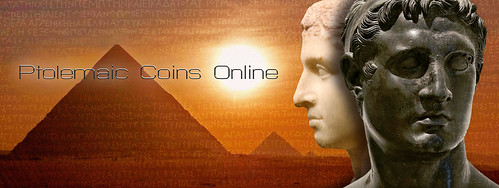
An Important Update to Ptolemaic Coins Online
In 2018, the ANS launched Ptolemaic Coins Online (numismatics.org/pco) as part of the National Endowment for the Humanities funded Hellenistic Royal Coinages project. Ptolemaic Coins Online (PCO) is a new research tool that will ultimately provide wide access to the coins listed in the print volumes of Coins of the Ptolemaic Empire by Catharine C. Lorber, published by the ANS in 2018, the first attempt to provide a new, comprehensive standard typology and catalogue for the coinage produced by the Ptolemaic dynasty of Egypt since Ioannis Svoronos’s Τα νομίσματα του κράτους των Πτολεμαίων published in 1904–1908.
The print volumes of Coins of the Ptolemaic Empire will eventually appear in four parts: Volume I appeared in 2018 covering the gold and silver coinage (Part I) and bronze coinage (Part II) of Ptolemy I (r. 323–282 BC) through Ptolemy IV (r. 221–204 BC). Volume II covering the gold and silver coinage (Part I) and bronze coinage (Part II) of Ptolemy V (r. 203–181 BC) through Cleopatra VII (r. 51–30 BC) is expected to appear in print by 2021. The newly updated version of PCO, released on April 24, 2020, now includes the bronze coinages found in Volume I, Part II of Coins of the Ptolemaic Empire, in addition to the gold and silver coinages found in Volume I, Part I.
As part of the new update, examples of 590 Ptolemaic bronze coins from the ANS collection have been added to PCO, bringing the total number of available examples of all coins on PCO to 3,200 from 12 museums located around the world.
As project co-director, Peter van Alfen, noted, "The inclusion of these Ptolemaic bronzes into PCO marks a major development for researchers worldwide since these coins remain some of the least understood coinages from antiquity. For researchers to have open access to a modern typology and to be able to see examples of the coins from collections around the world will undoubtedly help further our understanding of them."
To visit Ptolemaic Coins Online, see:
http://numismatics.org/pco/
To read the earlier E-Sylum article, see:
PTOLEMAIC COINS ONLINE ANNOUNCED (https://www.coinbooks.org/v22/esylum_v22n04a08.html)

MAY 2020 INTERNATIONAL TOKEN WEB CONFERENCE
Token collectors everywhere may be interested in the upcoming International Token Web Conference. Thanks to Yosef Sa'ar for passing this along. -Editor
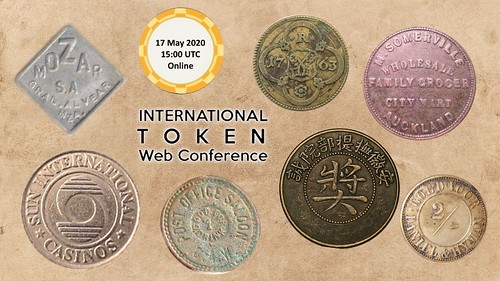
International Token Web Conference
Live Online Video Meeting
Sunday, 17 May 2020
Free video gathering of collectors and researchers. All types of numismatic tokens, all countries and all periods. Top speakers from around the world. Stay up to date at:
https://www.facebook.com/TokenWebConference/
Use this link for free registration. All participants must register.
https://bit.ly/TokenConferenceRegistration
Starting time is 15:00 UTC, and around the world:
08:00 Los Angeles;
11:00 New York;
12:00 Rio de Janeiro;
16:00 Great Britain, Portugal;
17:00 Central European Time;
18:00 Russia, Ukraine, Israel;
20:30 India;
22:00 Thailand;
23:00 China;
01:00 Sydney, Monday, 18 May.
Wow! Now THAT'S a true international conference. Good luck, and have fun, everyone. -Editor
EDWIN LEVENTHAL (1930-2020)
Charlie Davis writes:
"Miles Coggan called to tell me that Ed Leventhal passed away two weeks ago in Florida. Ed was better known as "J. J. Teaparty," the last of the Bromfield St coin dealers in Boston. Some 10-12 years ago, Ed sold the business to Miles and Liz Coggan and retired. Ed was a gentleman who during my early years in the coin business gave me more respect than I probably deserved. I have very fond memories of our dealings."
Here's Leventhal's entry in Pete Smith's American Numismatic Biographies on the Newman Portal. -Editor
Born in Boston. Graduate of Marietta College in Ohio in 1951. Married to Judith Berton with three sons. Trained as a chemist. Employed at his father's roller rink in the 1950's and 1960's.
He collects ancient coins and colonial paper money. Part time dealer prior to 1962. Since 1962 dealer affiliated with J. J. Teaparty in Boston. He served on the PNG Board 1983 to 1989. Treasurer of the Massachusetts Association of Coin Dealers in 1991.
bio by interview 8/15/91
To read the complete article, see:
Edwin Leventhal (https://nnp.wustl.edu/library/PersonDetail/1232)
From the company web site... -Editor
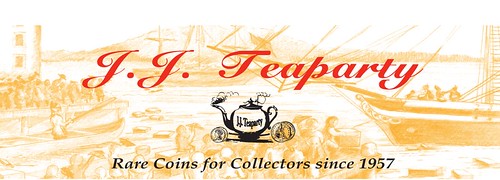
JJ TEAPARTY was established in 1957 by Ed Leventhal, and is the oldest continually running rare coin firm in Massachusetts. With just three owners since it's inception, J. J. Teaparty has been able to maintain continuity and quality throughout the decades we have been in business. Whether running a retail coin shop for 50 years or offering coins on our website, collectors have come to expect the best in quality merchandise as well as customer service. Customer satisfaction is our first priority. We offer a large selection of scarce and rare coins for collectors, as well as silver and gold bullion.
To read the complete article, see:
OLDEST RARE COIN FIRM (https://www.jjteaparty.com/about-us.php)

VIDEO: YELLOW FEVER & THE U.S. MINT
Another addition to the Newman Numismatic Portal is a new video on Yellow Fever and the U.S. Mint. Project Coordinator Len Augsburger provided the following report. -Editor
Yellow Fever Threatens the U.S. Mint
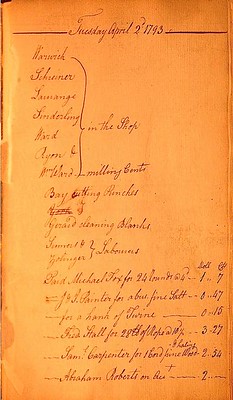 The early U.S. Mint in Philadelphia suffered from yellow fever throughout the 1790s. The toll in Philadelphia was extraordinary, with the fever claiming 10% of its
population in 1793 alone. Such numbers are in some way beyond our comprehension today, and, unless one has actually lived through it, the reality is hard to grasp.
The early U.S. Mint in Philadelphia suffered from yellow fever throughout the 1790s. The toll in Philadelphia was extraordinary, with the fever claiming 10% of its
population in 1793 alone. Such numbers are in some way beyond our comprehension today, and, unless one has actually lived through it, the reality is hard to grasp.
Like all Philadelphia institutions, the Mint suffered accordingly. In this recently released video, Lianna Spurrier sets the historical context and explores the impacts of yellow fever on the U.S. Mint. Today, the Mint has similarly closed some facilities, although circulation coinage continues to be manufactured.
Image: U.S. Mint Chief Coiner daily accounts, National Archives & Records Administration record group 104, entry 196.
Link to Yellow Fever & the U.S. Mint on Newman Portal:
https://nnp.wustl.edu/library/multimediadetail/529486?Year=2020&take=50
Link to U.S. Mint Chief Coiner daily accounts on Newman Portal:
https://nnp.wustl.edu/library/book/525968
VIDEO: EAGLES OF THE TYRANT COIN COLLECTION
These are selections from the David Lisot Video Library that feature news and personalities from the world of coin collecting. David has been attending coin conventions since
1972 and began videotaping in 1985. The Newman Numismatic Portal now lists all David's videos on their website at:
https://nnp.wustl.edu/library/multimediadetail/522852
Here's one on the $10 gold pieces of the Tyrant Coin Collection. -Editor
Eagles of the Tyrant Coin Collection
John (J.D.) Dannreuther, Host, David Lisot, Video Producer, CoinTelevision.com.
 This exhibit displayed at the Long Beach contains more than 300 gold Eagles and has every circulation strike from 1795 to 1933 with all the branch mint coins also
represented. There are Proofs of nearly every issue including the ultra- rare 1804, 1838, 1839, and 1857 issues, as well as both 1907 No Motto Indian Head Proofs and the unique
Matte finish 1909. There are dozens of finest known examples of both circulation strikes and Proofs. Numismatic consultant for the Eagles of the Tyrant Collection John Dannreuther
shows and discusses highlights of the exhibit.
This exhibit displayed at the Long Beach contains more than 300 gold Eagles and has every circulation strike from 1795 to 1933 with all the branch mint coins also
represented. There are Proofs of nearly every issue including the ultra- rare 1804, 1838, 1839, and 1857 issues, as well as both 1907 No Motto Indian Head Proofs and the unique
Matte finish 1909. There are dozens of finest known examples of both circulation strikes and Proofs. Numismatic consultant for the Eagles of the Tyrant Collection John Dannreuther
shows and discusses highlights of the exhibit.
LBE20-002
29:37
An excerpt of the video is available for viewing on the Coin Television YouTube Channel at:
https://youtu.be/q_MSnldyDH0
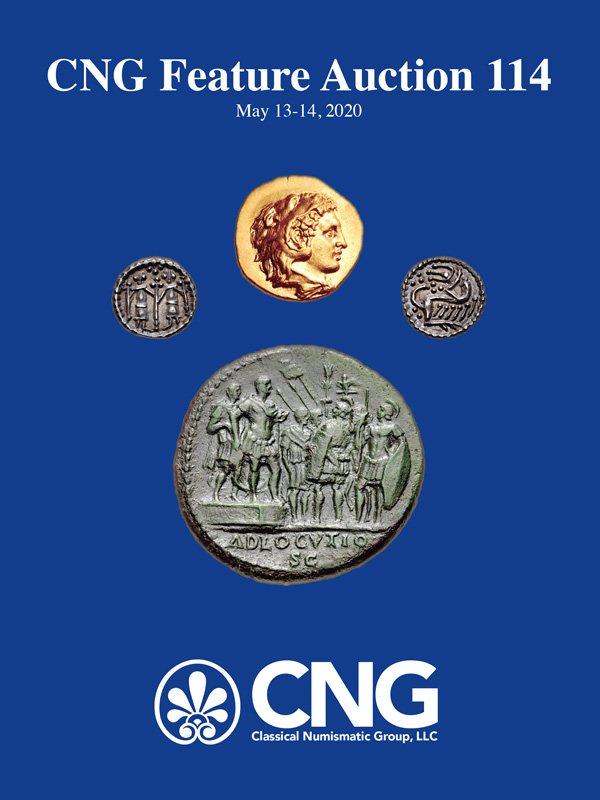
NORBERT LANDRY'S COIN ALBUM
 As noted earlier, one of my recent projects has been compiling citations of numismatic articles in non-numismatic publication for the Newman Numismatic Portal. The July
1866 issue of The Historical Magazine included a report from the Boston Numismatic Society. The article has been transcribed by NNP's Kelli West.
As noted earlier, one of my recent projects has been compiling citations of numismatic articles in non-numismatic publication for the Newman Numismatic Portal. The July
1866 issue of The Historical Magazine included a report from the Boston Numismatic Society. The article has been transcribed by NNP's Kelli West.
What I found most interesting was the description of the "coin album", which surely must be one of the earliest examples of a coin storage product in this country. -Editor
The regular monthly meeting of this Society was held on Thursday afternoon. The President read a letter from the Secretary, Mr. Appleton, dated Paris, May 16, mentioning many rare coins and medals he had purchased in Rome, Florence, and elsewhere. He describes a visit to the Kirchenian Museum at Rome, formed by an old Jesuit two hundred years ago, and thought to contain the most perfect series in existence of medieval curiosities then open to Florence, lent by the owners, in which was a large collection of Italian coins of cities and provinces.
Mr. Fowle exhibited a silver dracon of Corinth and silver coins of Trajan and Vespasian, a Roman family coin and a number of fine bronze pieces, both Greek and Roman.
Mr. Wiggin presented to the society, in behalf of the inventor, Mr. Norbert Landry of San Francisco, Cal., a "coin album," designed for the safe exhibition of coins, so that they may be neither soiled nor stolen by the curious. The coins are placed between two sheets of glass, inclosed [sic] in wooden frames revolving on an axle within a box and occupping [sic] but half a circle, so that the box may be closed. The box may thus be opened and the separate layers of coins turned over successively and look at, something like the views in a large stereoscope. The invention was carefully examined by the members, who considered it very well adapted for small private collections; and a vote of thanks was passed to Mr. Landry for his kindness in presenting it to the Society. Mr. Wiggin called the attention of the Society to some exceedingly curious gold and silver Roman Catholic medals, charms, crosses, etc., recently brought from Mexico. Among them was a reliquary of "San Ignacio de Loyola," in the form of a book of heavy gold, with relics of St. Philip de Neri and St. Joseph.
A present of a Lincoln medal in white metal, having on the reverse his famous words, "With malice towards none, with charity for all," was received from the engraver, Mr. J. A. Bolen of Springfield, Mass. Mr. B. Alonzo Brock of Richmond, Va., was unanimously elected a corresponding member.
I found this item in the Annual Report of the Commissioner of Patents for the year 1866. -Editor
No. 55,121. —Norbert LANDRY, San Francisco, Cal.—Coin Holder.—May 29, 1866– The leaves have panelled recesses, upon or between whose glass surfaces the medals or coins are placed, and rotate upon an axis to display them in succession. Claim.–The arrangement of coins and medals upon a vertical inclined or horizontal axis, between or upon transparent substances, to be revolved at pleasure, for the purpose of displaying said coins or medals, substantially as herein described and set forth.
Here's a diagram from the application. -Editor

To read the complete patent, see:
Coin-holder (https://patents.google.com/patent/US55121)
The San Francisco Examiner for December 12, 1878 reports on the suicide of a banker named Norbert Landry. The December 19, 1878 issue has an article about the man's estate which included "the patent right of his "coin-holder," coins and medals to his brother, Joseph Napoleon Landry, of New River, Louisiana." -Editor
Coin album researcher David Lange writes:
"It's not too different in concept from what Eliasberg used to display his collection, though clearly smaller.
"I did not know about this, and clearly it did not catch on at the time. I'd be very surprised if even a single example survives, but I'll keep watching eBay!"
Len Augsburger reminded me of a display at last year's ANA World's Fair of Money with a number of U.S. Patent models relating to coins. I had photographed some of the cases for my Numismatic Diary. A close look at my photo revealed that the patent models were part of an exhibit on U.S. gold coins. Erwin E. Brauer won First Place in Class 15 for "1795-1933 Major Design Types of Regular-Issue American Gold Coins." As it turns out, he's an E-Sylum reader, so I sent him a draft of this article for comment. -Editor
Erv Brauer writes:
"I'm excited to hear from you. I have been collecting for 60 years. I was in the right place at the right time to connect with Cliff Petersen in the Los Angeles area when he owned the remaining neglected US Patent Models in the early 1970's. Over years, I obtained about fifty very small to large models connected to numismatics, the only large collection extant. They have been my collecting and research specialty since the 1970's.
"So when I saw Norbert Landry in your email, I knew the name. In fact, I am lucky enough to have Landry's original patent model! It's taller than a 3 inch display case. I built a folding plexiglass case for the spring Michigan State show as non-competitive exhibit for its first time out. Same footprint as a 3 inch case but 24 inches tall.
"The model is full size, about 10 or 12 inches, wood holders on an iron rod as pictured. No coins. Some chips and damage as is normal. The models are in storage. I'm glad to hear that old Norbert's idea has seen the light."
Wow! What a delight to know that the original patent model still exists! We can all look forward to seeing it someday, or at least a photograph once it comes back out of storage. Thanks, everyone! This made my day. -Editor
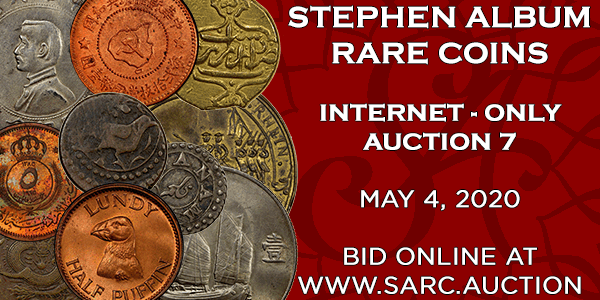
AUCTION HOUSES RAMPING UP ONLINE SALES
The Antique Trade Gazette reports positive results for recent online sales. -Editor
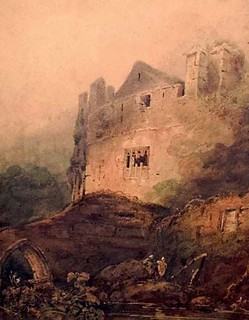 After a month's hiatus, a number of top-tier regional auction houses are returning to the rostrum to conduct ‘live online' sales.
After a month's hiatus, a number of top-tier regional auction houses are returning to the rostrum to conduct ‘live online' sales.
In accordance with social-distancing rules, these will typically be held by an auctioneer alone in the saleroom with the input of a handful of staff working remotely. Some firms will also be using timed online auctions.
Mallams, one of many UK regional firms that temporarily closed their doors on March 23, has taken the decision to begin selling remotely in early June via live online only auctions. "After looking at recent sales, and particularly the online-only Asian art sales that Christie's have run for a number of years, we felt this was the format that we should adopt," said director Robin Fisher.
"Vendors have been very positive and understanding."
The revised calendar will include the firm's traditional two-day sale of Asian art in Cheltenham (now scheduled for June 3-4), with more than 700 lots, and an Oxford two-day of Jewellery, Watches, Silver & Objets de vertu sale on June 17-18.
The merchandise offered was consigned pre-lockdown before the saleroom closed and many of the staff placed on furlough. While Mallams is continuing valuations by remote means, Fisher said the firm is not physically receiving any new consignments.
"Travelling to a saleroom does not qualify as an essential journey and using couriers presents unnecessary risk. We have decided to wait until the offices reopen."
However, provisions have been put in place to provide ‘contact-free' delivery to buyers by courier, and free storage is being provided until travel restrictions are lifted.
The new normal
Online sales – whether live online only or timed online – have become the new normal in the market since March with strong results posted in a wide range of categories,
encouraging more auction houses to move to this format.
For example, Gorringe's weekly sale held as live online only on April 20 attracted more than 900 bidders on thesaleroom.com and achieved a sell-through rate of more than 92%.
A timed sale of watches held by Fellows that ended on the same day attracted 1600 registrants – a house record for a timed sale – and achieved a healthy 87% sell-through rate.
Sales formerly postponed by Special Auction Services and Hansons are also being rescheduled as online events.
To read the complete article, see:
Auction calendar begins revival via the
virtual rostrum (https://www.antiquestradegazette.com/print-edition/2020/may/2440/news/auction-calendar-begins-revival-via-the-virtual-rostrum/)
But the picture isn't entirely rosy. Here's a take on the art market from The Hustle email on April 28, 2020. -Editor
SOLD TO THE MILDEST BIDDER
Sotheby's is losing millions because online auctions just aren't that exciting
Ultra-wealthy auction buyers going virtual -- but that's bidder news for big-name houses like Sotheby's and Christie's.
With in-person events canceled, the number of online auctions jumped by 63% over the past month. And last week, Sotheby's set a new online record, roping in a $6.4m sales haul from one event.
The downside: That pales in comparison to its in-person auction record of $110.7m. Those shortfalls forced Sotheby's to furlough 12% of its staff.
Do I hear frugal spending?
The average sales price in March clocked in at ~$6.9k -- well below the $40k+ average throughout 2019.
This isn't a story of rich people getting stingy because they blew all their money escaping to secret disaster bunkers. The real reason may have to do with the blandness of the virtual bid.
Online auctions are a little too rational
The culprit is a phenomenon called "auction fever" -- the adrenaline spike that pushes people to spend more than they ever intended to in the heat of a bidding war.
Auction fever gets amplified when you're in person.
Packed into a room, surrounded by colleagues, listening to the auctioneer shout out dollar figures, bidders go bananas.
It's such a problem that wealthy bidders sometimes send out minions to bid for them -- in part to ensure they don't spend above their max price.
Typing a bid into your computer from your living room just doesn't have the same thrill.
How is the online effect impacting the numismatic world? When all this started the transition to online auctions seemed to go pretty smoothly for the major houses. Even the marquee big-ticket items sold, although some thought the prices were a little soft. What about the auction fever effect? Could that be a cause of softness?
As an engineer and a buyer I'm all for the rationality of individual online bidding. Yet I don't think live online sales are lacking when it comes to the auction fever effect. You don't have to be there in the room to get excited over the prospect of winning a prized item or get angry or fearful over the prospect of losing out. -Editor

CORONAVIRUS UPDATES: MAY 3, 2020
Here's another compilation of coronavirus updates from readers, organizations and companies. -Editor
NAV Successfully Trials Video Meetings (April 18, 2020)
Numismatic Association of Victoria Secretary Darren Burgess writes:
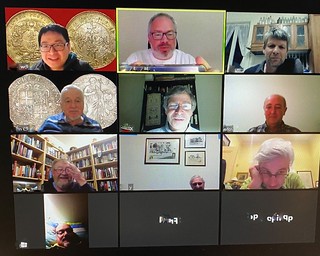 "At the beginning of 2020 April 18 was the date set for the Numismatic Association of Victoria's 1,077th meeting. Little did we know at that time that it would
be such an unusual and fun event. Like most places around the world at this time the Australian State of Victoria has a number of restrictions on gatherings, and as such the NAV
recently trialled on-line meetings.
"At the beginning of 2020 April 18 was the date set for the Numismatic Association of Victoria's 1,077th meeting. Little did we know at that time that it would
be such an unusual and fun event. Like most places around the world at this time the Australian State of Victoria has a number of restrictions on gatherings, and as such the NAV
recently trialled on-line meetings.
"Having successfully conducted a committee meeting it was decided to give this format a wider audience, so on 18th April eleven members and a visitor from the Geelong Numismatic Society, attended the NAV's first virtual meeting. Topics ranged from the War of Spanish Succession to Tom & Jerry and everything in between. We've had nothing but positive responses to this format and we're looking to extend the use of this technology to other clubs throughout the State. We may even use this format even when restrictions are lifted a so more remote and interstate members can attend.
 "Members without internet are not being left behind though as we'll be issuing an irregular newsletter as well as our regular publication of the Victorian
Numismatic Journal (VNJ). The latest edition of the VNJ carries the important message on the back cover to "keep calm and coin on". Members have also been in contact
with each other on a regular basis checking in on the more vulnerable members of our numismatic community.
"Members without internet are not being left behind though as we'll be issuing an irregular newsletter as well as our regular publication of the Victorian
Numismatic Journal (VNJ). The latest edition of the VNJ carries the important message on the back cover to "keep calm and coin on". Members have also been in contact
with each other on a regular basis checking in on the more vulnerable members of our numismatic community.
"The Numismatic Association of Victoria (NAV) was founded in 1946 and since then the association's aims and activities have largely remained unchanged. Members attend monthly meetings, receive copies of our publications, and have access to our archives through our website (navic.org.au), which we've recently opened for all numismatists, wherever they're based, to access in these strange and challenging times.."
May 2020 PAN Show Cancelled (April 23, 2020)
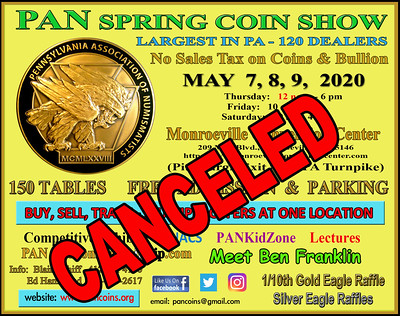
"Our May 7 – 9, 2020 Spring Coin Show is CANCELED. The State of Pennsylvania has extended the stay at home mandate to May 8th. Our next coin show will be our Fall event scheduled for October 29 – 31. We are disappointed but our concern is for the health and safety of our attendees and dealers.
"PAN will focus all of our great energy to the American Numismatic Association World's Fair of Money to be held at the David Lawrence Convention Center Pittsburgh, PA on August 4 – 8, 2020. We are the host organization and invite all of our PAN show supporters to attend."
To visit the PAN website, see:
https://pancoins.org/
Coins and Computation Video Conference (April 25, 2020)
Last Saturday I attended the members-only American Numismatic Society video conference Coins and Computation: New Developments in the Computer-Aided Die Study with Zachary Taylor and Dr. Peter van Alfen. -Editor
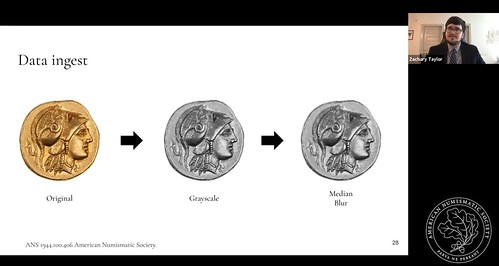
Dr. van Alfen writes:
"We've posted the recording of the CADS Money Talks on our YouTube channel. There were a total of 83 people who signed up, quite a few more (!!) than we're normally able to host at our Money Talks at Varick Street."
It was a great conference, and it was nice to "see" so many people online. Video conferencing isn't a new technology, but it's recently become much easier and cheaper to use, opening up the medium to many new uses. With all of us forced away from in-person conferences, this is not only a great substitute, it will likely be a regular feature of numismatic conferences going forward, even once in-person events return. -Editor
To watch the complete video, see:
Coins and Computation: New Developments in the Computer-Aided Die Study (https://www.youtube.com/watch?v=wF6aZdhc0wg)
To read the earlier E-Sylum article, see:
ANS VIDEO CONFERENCE: COMPUTER-AIDED DIE STUDY (https://www.coinbooks.org/v23/esylum_v23n15a22.html)
Money Trend Magazine Bankrupt (April 28, 2020)
While perhaps unrelated to the coronavirus pandemic, as noted earlier, financial crises tend to accelerate the inevitable. According to an article by Hans-Ludwig Grabowski in the Geldscheine-Online newsletter, the Austrian firm that publishes money trend magazine has filed for bankruptcy. -Editor
Google translation:
 "The "Moneytrend" Verlag GmbH from Vienna had to file for bankruptcy!
"The "Moneytrend" Verlag GmbH from Vienna had to file for bankruptcy!
"According to information from the Alpine Vendor Association (AKV) dated April 22, 2020, Moneytrend Verlag Gesellschaft mbH can no longer meet its current payment obligations. Bankruptcy proceedings were opened by the Vienna Commercial Court.
"The trade magazine "money trend" was first published in Switzerland in 1969.
"In 1996 it was taken over by the committed publisher Gerd-Volker Weege from Vienna, who founded his own newspaper while still at school and had been a passionate numismatist since his youth. In addition to the "money trend", more and more numismatic specialist books have now appeared in his publishing house.
"Gerd-Volker Weege died in May 2018. Since then, the publishing house has been continued by the next generation.
"The current April 2020 issue in the 52nd year of the magazine will probably remain the last issue. The number of subscribers had dropped so far for years that the magazine could no longer be economically successful. Now an insolvency administrator has to take care of the handling of the publishing house.
"With the "money trend", readers and the entire industry are losing an internationally renowned magazine for coins and paper money, which was largely shaped by Gerd-Volker Weege, who was a passionate advocate of the printed word, but also pursued new digital possibilities."
To read the complete article, see:
Die "money trend" ist insolvent!
(https://www.geldscheine-online.com/post/die-money-trend-ist-insolvent)
To read a CoinsWeekly article, see:
The End of Moneytrend (https://coinsweekly.com/the-end-of-moneytrend/)
Holabird April 2020 Sale Results (April 30, 2020)
Bidders aren't hiding their heads in the sand - they're still out there in force. Here's an excerpt from the press release for the recent Holabird sale. -Editor
 "The auction was led by Part 2 of the John Reynolds collections. His circus side show collection was just for starters. They also featured California tokens, medals
and shell cards, as well as his fabulous aviation mail (and California) postal history collection of more than 10,000 covers, plus his Pioneer postcard collection. The collections
contributed to a highly successful online auction.
"The auction was led by Part 2 of the John Reynolds collections. His circus side show collection was just for starters. They also featured California tokens, medals
and shell cards, as well as his fabulous aviation mail (and California) postal history collection of more than 10,000 covers, plus his Pioneer postcard collection. The collections
contributed to a highly successful online auction.
"This may have been a record-setting auction," remarked Fred Holabird, president and owner of Holabird Western Americana Collections. "Over time, we have mined many statistical patterns associated with collector interests, bidding practices and Internet visibility. We used this data to guide our marketing for this sale, and it was a near absolute success. The numbers bore this out."
"Holabird likened the auction room to "a war room," commenting, "With no live bidding in our gallery because of COVID-19, the room contained a complex array of computers and operators, with all phone participation handled by Zoom and our employees working remotely from home around the country. This high-tech approach to the business may well be the wave of the future."
"Following are additional highlights from the auction, which attracted more than 6,000 registered bidders, with just under 600 successful winning bidders and over 550 people participating online live over the course of the four days (with a high of just under 1,000 people online live at a time). The sale had less than ten lots reserved.
"Day 4 also topped the 750-lot mark, with categories that included tokens, numismatics, cowboy and Western, and bargains and dealer specials in multiple categories. Coin lovers were drawn to lot 4270 – a nicely organized hoard of Indian head pennies covering the years 1858-1909, about 1,450 pieces total, all sorted ($2,625). It was a wide variety archive, with most coins post-1880."
To read the complete article, see:
Massive circus side show collection brings
$37,500 in Holabird's Big Tent auction (https://artdaily.cc/news/123173/Massive-circus-side-show-collection-brings--37-500-in-Holabird-s-Big-Tent-auction#.Xqq7F2hKhPY)
Heritage Sale Results (May 1, 2020)
From the press release:
 "More than $33.6 million in rare coins and currency changed hands during the Central States actions, which were moved from Chicago to Heritage Auctions' global
headquarters in Dallas, April 23-26 due to the cancellation of the Central States Numismatic Society Convention (CSNS), April 23-26.
"More than $33.6 million in rare coins and currency changed hands during the Central States actions, which were moved from Chicago to Heritage Auctions' global
headquarters in Dallas, April 23-26 due to the cancellation of the Central States Numismatic Society Convention (CSNS), April 23-26.
"Considering the worldwide coronavirus crisis, participation was stellar, with more than 6,800 people participating in the auction online," said Jim Halperin, Co-founder of Heritage Auctions. "We watched top specimens receive numerous bids and there was exceptional interest in Colonial coins. The auction was 97 percent sold, by both number of lots and by dollar value."
Heritage also enjoys the highest Online dollar volume of any auction house on earth (source: Hiscox Report). The Internet's most popular auction-house website, HA.com, has more than 1,250,000 registered bidder-members and searchable free archives of five million past auction records with prices realized, descriptions and enlargeable photos. "
U.S. Mint Sales (May 1, 2020)
People are buying from the U.S. Mint as well. I don't follow U.S. Mint sales reports, but I found it interesting that the biggest-selling item last week was not a coin, but a medal. Here's an excerpt from a Coin Update article, which has the complete report. -Editor
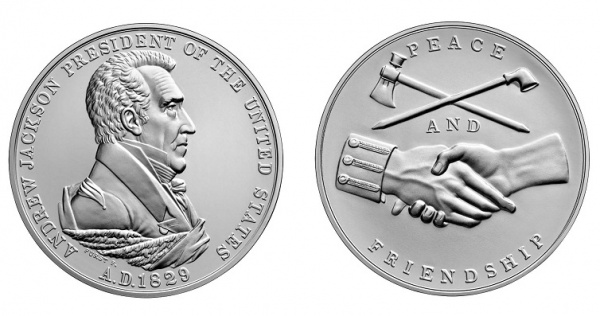
"This U.S. Mint numismatic sales report covers the week ending April 26, 2020. The Mint's best-selling product this week was the Andrew Jackson Presidential silver medal (S807), which sold 10,026 units. In second place was the 2020-S U.S. Mint Silver Proof Set (plus 2020-W Reverse Proof nickel) (20RH) with 7,486 sold. "
To read the complete article, see:
U.S. Mint sales report: Week ending April 26, 2020
(http://news.coinupdate.com/u-s-mint-sales-report-week-ending-april-26-2020/)
'Social Distancing' Medal
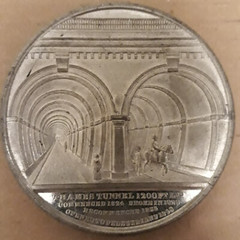 David Pickup writes:
David Pickup writes:
"I attach a photo of a recent purchase. Although it is a medallion from the Nineteenth Century it appears to demonstrate social distancing. The rider on the right is about to be arrested by a police officer for breaching the rules. The people on left are queuing for toilet rolls!"
Lockdown Humor
Lockdown Humor from the Good Clean Funnies List:
"People are using the word lockdown because they don't know how to spell kwarinteen.
"Ontario has banned groups larger than 5. If you're a family of 6, you're all about to find out who's the least favorite!
"If you get an email with the subject "Knock Knock,"... it's a Jehovah Witness working from home.
Day 36 of social isolation at home, and it's like being in Las Vegas. I'm losing money by the minute. Cocktails are acceptable at any hour. Nobody knows what time it is."
To read the complete article, see:
Lockdown Humor (https://gcfl.net/archive.php?funny=8144)
Dave Schenkman passed along several groaners. Here are a few, including one for bibliophiles. -Editor
I woke up this morning and forgot which side the sun rises from, then it dawned on me.
I bought my wife a fridge for her birthday. You should have seen her face light up when she opened it.
A man went into a library and asked, "Do you have any books on shelving?" The librarian said, "Yes, all of them."
I WISH all of my books were on shelves. I ran out of those a long time ago. -Editor
To read the earlier E-Sylum article, see:
CORONAVIRUS UPDATES: APRIL 26, 2020 (https://www.coinbooks.org/v23/esylum_v23n17a11.html)

CORONAVIRUS COIN SHOWS
Brian Alty of Northeast Numismatics penned this vision of socially-distanced coin shows. Thanks to Tom Caldwell for passing this along. -Editor
 Who would have ever thought there would be a period of 5 to 6 months or perhaps longer with out any coins shows? This has been the favored way of trading for many
collectors & dealers for decades. Despite the growing predominance of website transactions among most coin buyers today, this is still favored by many. It is hard to beat
the personal interaction and getting to view in person prospective purchases.
Who would have ever thought there would be a period of 5 to 6 months or perhaps longer with out any coins shows? This has been the favored way of trading for many
collectors & dealers for decades. Despite the growing predominance of website transactions among most coin buyers today, this is still favored by many. It is hard to beat
the personal interaction and getting to view in person prospective purchases.
These days dealers with established web sites are doing well. With folks having more time at home, most areas of commerce including numismatics are doing quite well. For those that are fortunate to be able to afford it, collecting seems more in vogue.
For those dealers that largely depend on shows for a living, coupled with collectors longing to browse their favored dealers' wares, there may be good news on the horizon. There is talk of starting a series of shows that will take into consideration all the necessary precautions needed to get dealers and collectors back together. More than just facial masks/gloves for all will be required; temperature checks would be mandatory before entering the show and perhaps the new immunity certificates that the airlines have just announced would need to be presented. Dealer-only hours would start either the evening before opening to the public or the first few hours of the show. Two to three day shows will be the maximum number of days. Admittance to the show would be staged likely 200 to 300 at one time with only limited number of hours allowed on the bourse floor to allow others admittance.
Special rules will be in play to allow social distancing for all. "Double Wides", a term more commonly defined for extra wide trailer park homes, will be the new normal with the bourse floor tables. Rather than the usual 3 x 8 foot table, this will be doubled and two tables will be used to essentially have 6 feet between dealer & customer. Also, tables will be more widely spaced between your neighboring dealers, again allowing proper distancing. Luckily the Allstate show cases we have all been using the past 60 years will still work as we just turn them sideways.
In an unusual move, Corona beer will be one of the show sponsors. Corona has recently introduced several new flavors and as show goers leave, a complimentary can will be handed to all. The first in this series of shows is expected to be in Florida, Southern California and New Jersey with the major grading services & CAC as sponsors. The idea of a special rate of $20.20 per coin or note for grading and authenticity for a limited number per person is being proposed. This endeavor has been in the works since April 1st. More details to follow. Stay tuned and stay safe.
Funny. Thanks.
Tom and I had an email conversation about this. I'm not a show promoter, but I've worked with some shows and it seems to me it would be very hard to pull off a socially-distanced coin show. Physically it's possible to spread everything out, but doubling space in two dimensions cuts capacity to one-fourth of the original floorplan. Creative layouts and the elimination of exhibit and club tables might allow table space for at most half the usual number of dealers.
Club shows and nearly every show with or without income from a major coin auction operates on thin margins. To break even with only half the dealer tables they would need a big discount on rent for the hall. The venues have a lot of expenses of their own just to keep the doors open and lights on - would they be willing and able to share the financial pain?
And what about the dealer perspective? If only half the normal number of dealers and public attend, they'll probably expect to do less wholesale and retail business, and would expect a discounted table fee, making it all the harder for the show organizer to break even, let alone book a profit.
We will get through this period somehow, but in-person events face an uphill battle in the interim. For another perspective, I reached out to American Numismatic Association Board member Shanna Schmidt. -Editor
Shanna writes:
"I'm on the convention committee for the Pittsburgh ANA and this is a real issue at the moment. I appreciate reading Brian's perspective and as a smaller dealer I would entertain smart ideas in order to have a show. At the moment the perspective amongst the committee for the ANA WFOM is to wait to see what is actually possible. We still don't know if the city of Pittsburgh will even allow a trade show. If they cancel the show then there is the answer. If they allow us to have it then likely August is as good a time as any to have a show if we have one since the COVID-19 will likely reappear in the Fall again.
"That said, it will undoubtedly be a smaller show regardless of whether the ANA cuts down on tables or limits people in. I believe that psychologically many people will opt out of traveling to a show because of fear or health issues. Many will just stay away and this isn't necessarily a bad thing since we need the show to be smaller. My one concern is how to choose who gets a table and who doesn't. Perhaps this will be the same scenario as the attendees - some dealers will just opt out. The large auctions that take place there will still be an important component of the ANA and right now there is no reason to think that they can't take place.
"What is important is for everyone to understand that this will pass and we will have trade shows again. For the moment it really is unknown and I urge my fellow dealers to find alternative ways to reach out to their customers. I'm setting up Zoom sessions with customers so they can see my coins. Other smaller dealers can do this too. My business has been affected by this virus and I'm not selling tons of coins right now despite hearing that some people are selling like gangbusters. I simply am trying to take things day by day and think logically about how to get back to business."
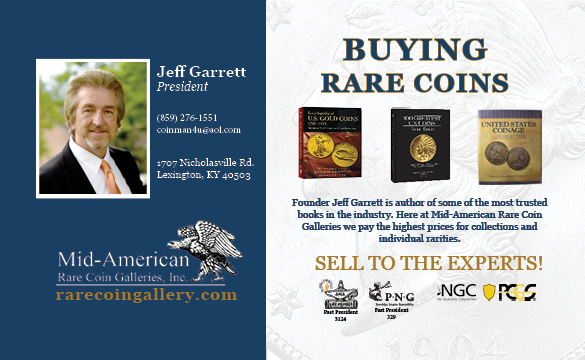
WORLD VS VIRUS COVID-19 TASK FORCE COIN
Lord Ashcroft proposed granting the George Cross medal to front line medical workers in the coronavirus pandemic. Other medals, challenge coins, and tacky souvenirs are inevitable, such as the "I Stayed Home Pandemic 2020" item mentioned earlier.
Several readers passed along stories this week with headlines like "The White House Gift Shop Is Now Selling This Absurd Commemorative Coin." I was unaware of any official White House gift shop other than perhaps the White House Historical Association, known for selling annual Christmas tree ornaments. I figured this was referencing some third-party product. The web site cited looked official and claimed to be offical, but poking around I could see that it was a private company offering.
Here are images and text from the White House Gift Shop site. -Editor
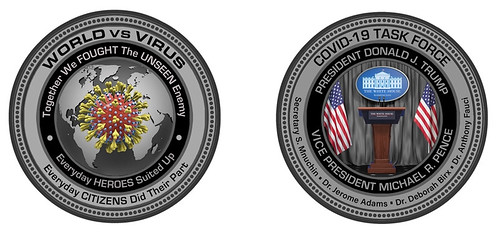
WORLD vs VIRUS MEMORIAL COIN &
PRESIDENT TRUMP'S COVID-19 TASK FORCE
Numbered Limited Edition Certificate to Match Edge Number on Coin
To read the complete item description, see:
COVID-19, WORLD VS THE UNSEEN ENEMY, EVERYDAY HEROES, PRESIDENT DONALD J, TRUMP, VICE PRESIDENT MICHAEL R.
PENCE, SECRETARY S. MNUUCHIN, DRS. JEROME ADAMS, DEBORAH BIRX, ANTHONY FAUCI, PRE-ORDER, HISTORIC MOMENTS IN HISTORY SERIES, SHIPS JUNE 15, 2020
(https://www.whitehousegiftshop.com/product-p/covid-heroes.htm)
Other non-government White House shops:
https://www.whitehousegifts.com/
https://shop.whitehousehistory.org/
Here's what the fact-checking Snopes web site concluded. -Editor
What's True The website WhiteHouseGiftShop.com is selling coronavirus commemorative coins.
What's False WhiteHouseGiftShop.com is not the official gift shop of the White House, and these commemorative coins were not officially sanctioned by the United States government.
In late April 2020, some social media users accused the White House of attempting to capitalize on the COVID-19 coronavirus disease pandemic by selling commemorative coins through the "White House Gift Shop"
The U.S. government is not selling coronavirus commemorative coins via the White House Gift Shop. The LGBTQ Nation article mentioned in the ... tweet is referring to the website WhiteHouseGiftShop.com. Although this website is selling coronavirus commemorative coins, and it does call itself the "White House Gift Shop," it is not officially affiliated with U.S. President Donald Trump, the U.S. government, or the White House.
To read the complete article, see:
https://www.snopes.com/fact-check/white-house-gift-shop-covid-coins/
(https://www.snopes.com/fact-check/white-house-gift-shop-covid-coins/)
Some of the articles readers sent do put ‘White House' in quotes and state that the coins are sold by the "privately-run White House store", though their opening paragraphs do not. -Editor
To read the complete article, see:
‘White House' Shop Sells the Gift No One Asked for:
$100 COVID-19 Commemorative Coins (https://www.thedailybeast.com/white-house-gift-shop-sells-covid-19-commemorative-coins?source=email&via=desktop)
Scott Miller forwarded this Artnet News article on contemporary art parodies of over-the-top Presidential coins. It identifies the maker of the "White House Gift Shop" piece, but did not get any comments from them. -Editor
The United States is still very much in the thick of the pandemic, but you wouldn't know it from looking at the latest product on offer at the White House Gift Shop: a commemorative coin celebrating the Trump Administration's heroic, victorious efforts to fight coronavirus.
The coin shows an artist's rendering of the coronavirus overlaid on a world map, and reads (with characteristically Trumpian capitalization), "World vs Virus: We Fought the Unseen Enemy. Everyday HEROES Suited Up. Everyday CITIZENS Did Their Part." The other side features the presidential podium, where Trump until recently delivered his controversial daily press briefings.
The coin is on sale for a cool $100—marked off from $125 for pre-orders. It was designed by Challenge Design, an Illinois and Indiana-based company specializing in commemorative coins. When reached by Artnet News, company owner and creative director Mary H. Harms declined to comment. The White House Gift Shop did not respond to inquiries.
The President's unique approach to coins has already inspired some artists to put their own twist on the form. Valery Estabrook presented her project, called "The Impeachmint," at last month's SPRING/BREAK Art Show in New York. In the series, she immortalizes the administration's lowest moments, such as Trump's impeachment.
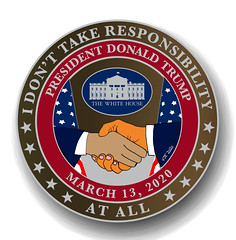 The artist was already planning to design a coin to memorialize the administration's response to the pandemic. But she was surprised to have been beaten to the punch by
the White House Gift Shop.
The artist was already planning to design a coin to memorialize the administration's response to the pandemic. But she was surprised to have been beaten to the punch by
the White House Gift Shop.
Her current working draft, available for pre-order for $99 ($1 less than the official coin!), features a quote from March 13 in which Trump denied that it was his fault that there were not sufficient coronavirus tests. "I don't take responsibility at all," said the president.
To read the complete article, see:
The White House Gift Shop Is Now Selling This Absurd Commemorative
Coin Honoring President Trump's Fight Against the Coronavirus (https://news.artnet.com/art-world/the-white-house-gift-shop-coronavirus-commemorative-coin-1848489)
To read the earlier E-Sylum articles, see:
LORD ASHCROFT: GEORGE CROSS FOR HEALTH WORKERS (https://www.coinbooks.org/v23/esylum_v23n16a30.html)
CORONAVIRUS UPDATES: APRIL 19, 2020 : I Stayed Home Pandemic 2020 Medal
(https://www.coinbooks.org/v23/esylum_v23n16a11.html)
PORTLAND SPANISH FLU MEDAL
Scott Miller submitted this example of a medal issued by the City of Portland, OR to volunteers during the Spanish flu epidemic. Thanks! -Editor
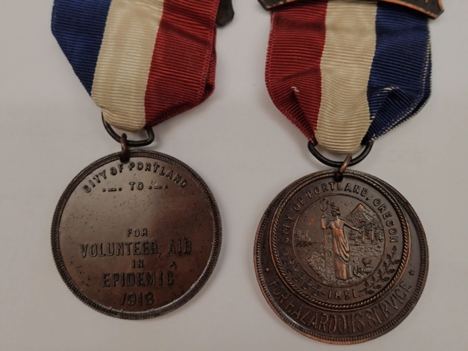
For more information, see:
Keller Auditorium: A hospital during Spanish Flu Pandemic
(https://www.koin.com/news/keller-auditorium-a-hospital-during-spanish-flu-pandemic/)
"Here is a contemporary notice about the presentation of the Portland medals. I don't know if anyone else was awarded this medal. From Monthly Bulletin, Spruce Production Division - U. S. Army, Loyal Legion of Loggers and Lumbermen, Vo. 2, No. 4, Dec. 1918 - Jan. 1919, p. 21"
To read the original article, see:
Monthly Bulletin, Volumes 1-2
(https://books.google.com/books?id=iKSbvE9DOkIC&pg=RA7-PA21&lpg=RA7-PA21#v=onepage&q&f=false)
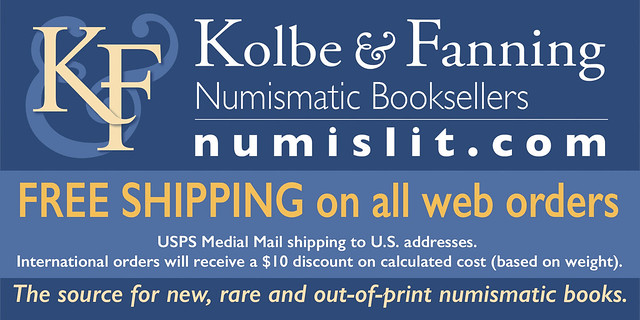
ERASED WURTZBACH INSCRIPTION: ARTHUR L. GRAY?
Last week Wayne Myers asked for our help in deciphering the erased name in a reinscribed copy of Carl Wurtzbach's Massachusetts Silver book. "Frank J. Kelly" was overwritten on Wayne's copy #20. All I could read was an "L" for the middle initial. -Editor
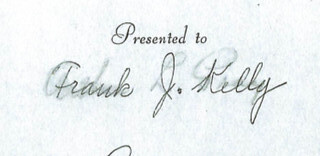
Ron Haller-Williams writes:
"Definitely "L" as middle initial, with first letter of surname being "G" or "P". I think "Gray" or just possibly "Grady". "Arthur L Gray" is a distinct possibility, but I don't have that much confidence ...
"My method: Create an "underlayer" the same tone as average background. Then delete the bits of the new name, so they don't continue to scream at you. Now see what's left. I then played around with brightness and contrast, then "posterised" it."
I thought of "Arthur" as well, but was too unsure to pose it. Great idea! Here's what Ron found. -Editor

I now think "Arthur L. Gray" is much more likely. I looked for the name on the Newman Portal and found an Arthur L. Gray buying coins in 1943 and 1944. The Wurtzbach book was published in 1937, but Ron found a sale of the Arthur L. Gray coin collection in a 1939 Morgenthau sale and wondered if this was the same person. As it turns out, Arthur Gray continued buying coins after the sale of his collection, so it does seem to be the same numismatist. Ron found this passage in the 2017 Pogue V sale of a 1793 Sheldon-13 Large Cent (lot 5090). -Editor
In 1943, this coin turned up among the remnants of Virgil Brand's remarkable hoard. The fertile Burdette G. Johnson archives provide the first documentary appearance of this coin since it was published in the American Journal of Numismatics in 1869. Arthur L. Gray, a druggist from Saginaw who continued to collect even after he consigned a superb collection to the February 1939 J.C. Morgenthau & Co. sale, was sent this coin on August 23, 1943.
To read the sale catalogs on the Newman Portal, see:
Sale number 394 : rare coins of the world from the Waldo Newcomer collection : the United States coin
collection of Arthur L. Gray ... [02/23-24/1939] (https://archive.org/details/salenumberrareco00morg/page/n1/mode/2up)
The D. Brent Pogue Collection: Masterpieces of United States Coinage, Part V
(https://archive.org/details/Pogue_V_Online_Catalog/page/n168/mode/2up)
Ron adds:
I really don't think Carl would have struck somebody like Gray off the list -- maybe not put him on the list, but I can't see a striking-off (unless something really bad happened between them during a fairly-narrowly-defined space of time).
Even the 1939 sale hadn't happened by the time Frank acquired it. what if Carl Wurtzbach accidentally inscribed two copies to Arthur Gray, and altered the second one? - e.g. broke for a meal etc in between, without having ticked off Arthur Gray on the list he (Carl) was working from.
Wayne Myers writes:
"Thank you! Do any of our readers have a copy dedicated to Arthur Gray? I guess we will never know why this was erased."
Great mysteries always raise new questions. Thanks, everyone! -Editor
To read the earlier E-Sylum article, see:
NOTES FROM E-SYLUM READERS: APRIL 26, 2020 : Query: Wurtzbach Inscription
(https://www.coinbooks.org/v23/esylum_v23n17a12.html)
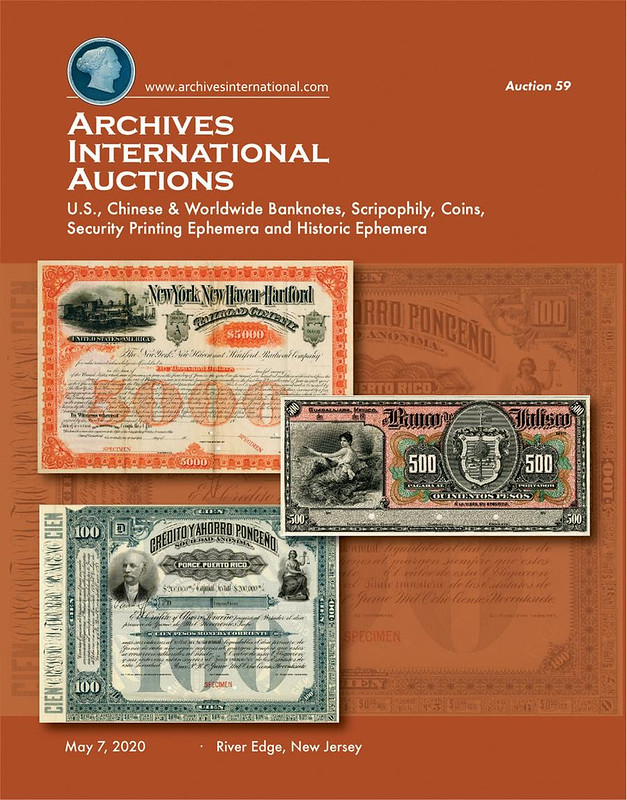
MORE ON THE 1740 PHILADELPHIA HALFPENCE RIOT
In an earlier issue I asked about an incident regarding imported halfpence reported in Philadelphia in 1740. -Editor
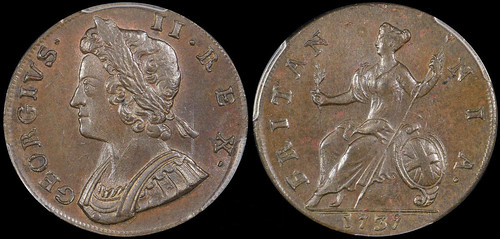
Ray Williams writes:
"It says halfpence were imported and being accepted in commerce at 5 for 4 pence. Were 1/2d actually valued at 1d in commerce? "
Jeff Rock writes:
"England seldom had enough copper coins for their own needs - thus the rash of counterfeits pouring out in just about every area of the island! It seems unlikely that they would send a lot of badly needed halfpence to their American colonies at the cost of their own citizens at home, unless they absolutely had to, such as the 1749 Mermaid shipment, and the bulk of what was in circulation in America at the time likely mirrored what was in circulation in England - counterfeits and damaged or heavily worn regals, with a smattering of newer, better-weight coins. America would seem a logical dumping ground for the outdated (and presumably quite worn and lightweight) William III issues, as well as the lighter-weight Irish coinage.
"Full weight British halfpence would have circulated here at penny value at the time - the reason that the Rosa Americana coins are half the size of the British coins of the era (i.e. the Rosa Americana halfpenny was the size of a British farthing, the penny the size of a British halfpenny). Counterfeits would likely not be full weight, but in this era there likely wouldn't have been enough of them to make an appreciable difference to their value in commerce. But if a very large quantity arrived that would change things, and the 5 for 4 pence is an attempt to adjust their value to keep them fairly priced alongside regal halfpence - and, most likely, to discourage more being sent over."
Lou Jordan writes:
"This episode is well-known. I mentioned it on the Notre Dame website in the section on British regal coppers in America at: https://coins.nd.edu/ColCoin/ColCoinIntros/Br-Copper.intro.html
"I called it a demonstration rather than a riot. It is also mentioned in Phil Mossman's Money of the American Colonies and Confederation book and in several other sources."
Lou kindly provided the website text and highlighted the key passage in bold. -Editor
As British coppers entered the colonial economy in larger quantities during 1730s-1750s a problem arose over their value, since they usually traded at a premium, higher than face value. This sometimes caused a problem as is seen in the following two episodes from New York and Philadelphia.
On December 16, 1737 New York passed an act stating:
Whereas for some years past great quantities of English copper halfpence and farthings have been from time to time imported into this colony which have been and are paid and received in the Markets and other payments by Common consent of the People at a higher rate that their Insrinsik Value and Whereas by the Conveniency of such copper money passing in Small payments the Importation of the Same is still continued...
The act went on to state the importation of more than ten shillings in coppers into the colony was subject to confiscation.
The problem was not with the coppers but with their valuation. Since coinage was at a premium in the colonies most coins were accepted above their face value. British and Irish coppers were no exception. In New York English halfpence were accepted at twice their face value, so twelve British halfpence equaled a New York shilling of account. As New York valued the Spanish dollar at eight shillings, one could obtain a Spanish dollar for 96 British halfpence. Whereas in Boston, it took eighteen British halfpence to equal a Massachusetts shilling and, as they value the Spanish dollar at six shillings, a Spanish dollar cost 108 British halfpence. In Philadelphia there appear to have been various rates at this time, one rate was fifteen British halfpence to the Pennsylvania shilling. As Pennsylvania valued the Spanish dollar at 7s6d (90d), a Spanish dollar could be obtained for 112.5 British halfpence in Philadelphia if someone was using the fifteen halfpence rate (another lower rate that came into general use in Philadelphia during the Confederation era was 14 British halfpence to the shilling or 105 halfpence to the Spanish dollar). Clearly it was advantageous to bring coppers to New York and exchange them for Spanish dollars. Bostonians obtained a 12.5% profit and some Philadelphians could reap a 17% profit. New York first handled this situation by limiting copper imports from other colonies. However, they still accepted casks of coins brought over from England.
In Philadelphia the problem of copper valuation led to a demonstration on January 2, 1741. Some merchants were accepting British halfpence at the New York rate of double (100%) their value, so that one halfpenny equalled one Pennsylvania penny. Other merchants were trading them at only 60% over face value, so that five halfpence equalled four Pennsylvania pence. The situation was so confusing and disruptive that on January 2nd the city bakers refused to open their shops causing a minor crisis. This event forced the city and the merchants to work together to end this problem. The result was an edict by the mayor of Philadelphia on June 18, 1741 stating:
Whereas the Currency of English Half-pence in this Province, has long been found convenient for the Use of Inhabitants, for small Change; but the Value or Rate at which they should pass not having been settled by any Authority, they have often received at too high a Value, by Reason whereof great Quantities of Half-pence were imported from the Neighboring Colonies, and exchanged for our Gold and Silver,
And whereas at a late General Meeting of the Merchants and others, it was agreed that the said Half-pence should be received at Fifteen for One Shilling, current Money of this Province, which was judged to be the nearest to such Value as might discourage too great a Quantity being imported, and at the same Time prevent their being carried away.
[it is declared]...any Person or Persons who shall refuse to receive English Half-pence in small Payments, at the Rate of Fifteen English Half-pence for One Shilling, ought to be deemed a Disturber of the Publick Peace of the Province.
The rate of fifteen British halfpence to the Pennsylvania shilling (or 60% over face value) became the standard for the entire colony and was also adopted by New Jersey.
Jeff Rock adds:
"What is unknown though, is just what these counterfeits were! The George II counterfeit halfpence are much rarer than the George III issues - and the majority of counterfeits with George II bust styles were made much later, at least in the 1770s and as late as the 1790s. There aren't a lot of George II counterfeits dated 1740 and earlier that are thought to have been made in that period (i.e. the Simians were made in the 1790s, the Defiant Heads may be of the general era but their dates start with 1749, etc.). It could be that these were cast counterfeits, or that they were counterfeits of the George I or even William III issues and not George II coins at all. You just wish that journalists were a little more precise about their reporting at the time!"
Thanks, everyone! Interesting topic. -Editor
To read the earlier E-Sylum article, see:
THE 1740 PHILADELPHIA HALFPENCE RIOT (https://www.coinbooks.org/v23/esylum_v23n16a20.html)
THE BOOK BAZARRE
NOTES FROM E-SYLUM READERS: MAY 3, 2020
Naming The Asylum (and The E-Sylum)
ANA Edition reader Felix Bronstein writes:
"Would you mind explaining the origin of using the name Asylum (and E-Sylum)?"
 Certainly! The Numismatic Bibliomania Society was founded in 1979 by Jack Collins and George Kolbe. "Bibliomania" is defined variously as a "passionate
enthusiasm for collecting and possessing books", an "excessive fondness for acquiring and possessing books" and an "extreme preoccupation with collecting
books". Literally, it is a mania about books. Bibliomaniacs are often termed "book nuts" (affectionately or perjoratively). We were numismatic
bibliomanics.
Certainly! The Numismatic Bibliomania Society was founded in 1979 by Jack Collins and George Kolbe. "Bibliomania" is defined variously as a "passionate
enthusiasm for collecting and possessing books", an "excessive fondness for acquiring and possessing books" and an "extreme preoccupation with collecting
books". Literally, it is a mania about books. Bibliomaniacs are often termed "book nuts" (affectionately or perjoratively). We were numismatic
bibliomanics.
There was some debate over what to call the group's journal. One side leaned toward something formal and scholarly; another side argued in favor of something simple and fun. The fun side won out. While it may not be fully politically correct today, "The Asylum" became the name of the journal because, well, insane people ("maniacs") were sent to live in the Insane Asylum.
Fast forward to the 1990s. The Internet came along and I started an email newsletter for NBS members. In the spirit of the early 'net, it was free and open to all as a way to promote the society, engage members, and recruit newcomers. There was another discussion of what to call it. I thought of "The Babbler", in keeping with the insanity theme. But the overwhelming consensus choice was The E-Sylum as the clear electronic counterpart to our print journal, The Asylum.
-Editor
Were 1883 No Cents Nickels Released in 1930s?
Jonathan K Kern of Lexington KY writes:
 "About the 1883 no cent nickels -my understanding from some news article buried deep in my library is that the nickels were not all released in 1883 as the fraud
issue of gold plating them became apparent. They were held in the treasury until 1933 when gold coins were withdrawn. When released in 1933 or 1934 they were an instant anomaly to
the public in an era of buffalo nickels, and saved. Hence, many high grade examples."
"About the 1883 no cent nickels -my understanding from some news article buried deep in my library is that the nickels were not all released in 1883 as the fraud
issue of gold plating them became apparent. They were held in the treasury until 1933 when gold coins were withdrawn. When released in 1933 or 1934 they were an instant anomaly to
the public in an era of buffalo nickels, and saved. Hence, many high grade examples."
Interesting story. I guess it's plausible that the Treasury stopped releasing these at some point, but it's more likely that the coins would have been destroyed rather than held for decades. I tried searching on a newspaper database but came up empty. If you come across that article, let us know. Has anyone else seen this report? Is there any other evidence that the Treasury released 1883 Nickels in the 20th century? -Editor
To read earlier E-Sylum articles, see:
1883 NO CENTS LIBERTY NICKELS HOARD OFFERED (https://www.coinbooks.org/v21/esylum_v21n13a24.html)
THE 1883 NICKEL RUSH (https://www.coinbooks.org/v23/esylum_v23n16a21.html)
NOTES FROM E-SYLUM READERS: APRIL 26, 2020 : More on 1883 No Cents Nickels
(https://www.coinbooks.org/v23/esylum_v23n17a12.html)
St. George First Non-Royal on British Coinage
Gary Greenbaum writes:
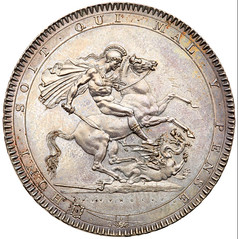 "In reading about St. George in your latest issue, it's possibly worth noting that his appearance on the sovereign in 1817 was the first real person not a royal to
appear on a British coin. (Dismissing the unreleased Cromwell crown of the 17th century, which was English, rather than British). The first non-royal person on a British stamp
waited until 1964, with William Shakespeare."
"In reading about St. George in your latest issue, it's possibly worth noting that his appearance on the sovereign in 1817 was the first real person not a royal to
appear on a British coin. (Dismissing the unreleased Cromwell crown of the 17th century, which was English, rather than British). The first non-royal person on a British stamp
waited until 1964, with William Shakespeare."
Good point. Thanks! -Wayne -Editor
To read the earlier E-Sylum article, see:
COINS AS TALISMANS: SAINT GEORGE'S DAY (https://www.coinbooks.org/v23/esylum_v23n17a10.html)
Brit vs. Britt
Gary Greenbaum adds this note about Latin abbreviations. -Editor
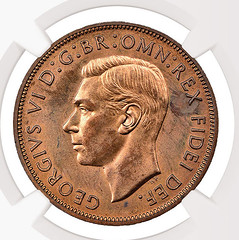 The doubling of the T in Britt, although it stands for Britanniarum, is explained in A New History of the Royal Mint, p. 511 as follows, dealing when Victoria's
version of that inscription was adopted in 1860 with the bronze British penny:
The doubling of the T in Britt, although it stands for Britanniarum, is explained in A New History of the Royal Mint, p. 511 as follows, dealing when Victoria's
version of that inscription was adopted in 1860 with the bronze British penny:
On one point there was later public controversy, the doubling of the T of BRITT in the inscription on the obverse. Here the classical scholarship of the chancellor himself [William E. Gladstone] had saved the Mint from error, but lesser minds failed to understand the application of the Latin rule that the final consonant of an abbreviation should be doubled when necessary to indicate the plural.
Dyer, G.P.; Gaspar, P.P. (1992), "Reform, the New Technology and Tower Hill", in Challis, C.E. (ed.), A New History of the Royal Mint, Cambridge: Cambridge University Press, pp. 398–606, ISBN 978-0-521-24026-0"
Thanks again. -Editor
To read the earlier E-Sylum articles, see:
THE UNIQUE 1952 GEORGE VI PROOF PENNY (https://www.coinbooks.org/v23/esylum_v23n16a24.html)
1952 Proof Penny Legend Translation (https://www.coinbooks.org/v23/esylum_v23n17a12.html)
On Paper Thickness
In the maybe-you-really-CAN-be-too-thin department, Nick Graver writes:
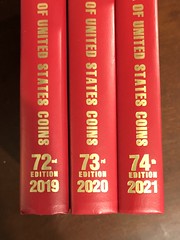 "A recent issue had a chat about thickness of the Red Book. I don't buy one every year. I wanted to suggest that people check the actual page count, not issue
thickness. A printer might use a slightly thinner paper stock which makes a book thinner while still having full content.
"A recent issue had a chat about thickness of the Red Book. I don't buy one every year. I wanted to suggest that people check the actual page count, not issue
thickness. A printer might use a slightly thinner paper stock which makes a book thinner while still having full content.
"I know the publisher of a camera price guide who says some readers are concerned when an issue is thinner than the previous one. So he continued with thick paper that made it a bigger and heavier book, clumsy to carry around and costly for each book that gets mailed. He used the term "bible paper" in the conversation."
Dennis Tucker of Whitman Publishing writes:
"Mr. Graver is correct, of course: the kind of paper used in a book will affect the thickness of the spine. It's something we're constantly attuned to, and an important factor in Whitman book designs. (We request templates from our printers for laying out our covers; spine width is a major part of the equation.)
"We choose paper with an eye toward quality and visual appeal. We want good color saturation and tonal contrast, and obviously it would be distracting if images or text bled through to the other side of the leaf.
 "For the 2021 edition of the Red Book we chose 50# Influence Matte, which has a ppi of 714. (Matte paper generally provides the greatest longevity, compared
to glossy or coated-matte papers.) We strive for consistency with the paper, for the sake of consistent spine widths, but we also stay flexible in our paper supply, in order to be
able to add pages while maintaining high quality.
"For the 2021 edition of the Red Book we chose 50# Influence Matte, which has a ppi of 714. (Matte paper generally provides the greatest longevity, compared
to glossy or coated-matte papers.) We strive for consistency with the paper, for the sake of consistent spine widths, but we also stay flexible in our paper supply, in order to be
able to add pages while maintaining high quality.
"The Red Book's page count has never gone down. In recent years it's been increasing. Today it's 464 pages plus endpapers and a bound business-reply card. Grabbing a random volume off my shelf: the 2014 edition was 448 pages plus endpapers and a card."
To read the earlier E-Sylum article, see:
NOTES FROM E-SYLUM READERS: APRIL 19, 2020 : 2021 Red Book Changes
(https://www.coinbooks.org/v23/esylum_v23n16a14.html)
Coronavirus Stimulus Check Spotted
Recently we discussed the collectibility of the CARES Act Economic Impact Payment checks. While many Americans received their payments via electronic funds transfer, many others received physical checks. Gary Beals provided this image of one. Thanks! -Editor
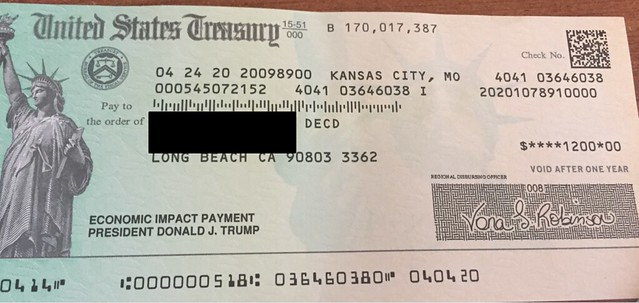
Gary writes:
"My mother-in-law died in August of last year — her $1200 stimulus check just arrived.
The envelope tells the recipient to check the box marked "deceased" if the person is no longer living and send it back. Mom died last August in the Los Angeles area at age 94. Her name was on the check, followed by DECD, a government code for the word Deceased — so the government knew she was not alive in 2020.
How many other errors such as this are happening nationally is unknown."
Gary's sister-in-law snapped the photo of the check; I blacked out some portions for privacy. As long as no one attempts to cash it, it might be fine to keep it. Great numismatic souvenir of our times. -Editor
To read the earlier E-Sylum article, see:
WILL CORONAVIRUS STIMULUS CHECKS BE COLLECTIBLE? (https://www.coinbooks.org/v23/esylum_v23n16a33.html)
Colonial Newsletter CD Sought
 Darryl Atchison writes:
Darryl Atchison writes:
"I am hoping that one our readers might have an unwanted copy of The Colonial Newsletter on disc up to issue 103. I have the disc from 104 to the final issue already. I know it's on the Newman Portal but I don't always have access to the internet. So, if I have it on CD, I can read it anywhere."
Can anyone help? Darryl can be reached at atchisondf@gmail.com . -Editor

MORE ON THE FORT BRIDGER WYOMING TOKENS
Michael Wehner submitted this additional information about the Fort Bridger Wyoming Territory tokens. Thanks! -Editor

$1.00 Fort Bridger Post Trader Token from the Feisel sale
I have some information about the WA Carter / Fort Bridger Wyoming Territory $1 token featured last week in Duane Feisel's auction. I bought a hoard of these tokens from one of the John Ford auctions of Stacks. Of the twenty-one tokens in the lot, there were three of the $1 denomination and a single 50 cent denomination with the remainder all 25 cents. Ford purchased all of them in the mid-1970s and they were off the market until I disbursed them. I believe this reflects the relative rarity of these denominations.
There is interesting history of Fort Bridger and William A. Carter's relationship to the Fort well documented on the internet.
For instance from, http://genealogytrails.com/wyo/uinta/fortbridgerhistory.html, "William Alexander Carter known as "Mr. Fort Bridger" was the most important individual at Fort Bridger, Wyoming and a key player in the economic development of the intermountain west."
Carter arrived in 1859 and stayed at Fort Bridger until his death in 1881, thus providing some context for the period during which this series of tokens was used. The tokens themselves are primitive compared to other tokens of this era. Jerry Adams has written that Carter ordered the tokens in 1868. The tokens of J.K. Moore at Camp Brown in Wyoming Territory closely resemble Carter's. Moore had previously worked for Carter at Fort Bridger, and Camp Brown was given that name in 1870 suggesting a similar maker and timeframe.
Some of the original buildings are still there and the site is part of the Wyoming park system. That website is
https://wyoparks.wyo.gov/index.php/places-to-go/fort-bridger
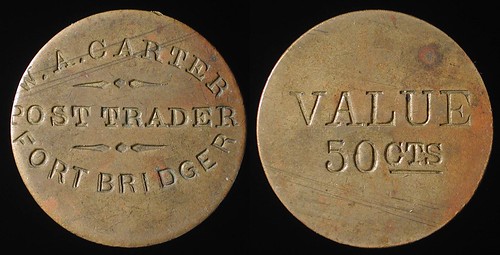
$0.50 Fort Bridger Post Trader Token from the Ford hoard
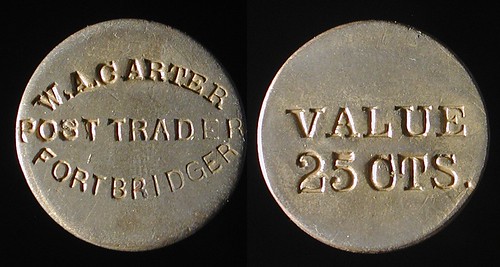
$0.25 Fort Bridger Post Trader Token from the Ford hoard
To read the earlier E-Sylum article, see:
FEISEL MAY 2020 TOKEN SALE SELECTIONS : Lot 117: Wyoming Territory Post Trader Token
(https://www.coinbooks.org/v23/esylum_v23n17a20.html)

VOCABULARY TERM: MAHOGANY FINISH
Dick Johnson submitted this entry from his Encyclopedia of Coin and Medal Terminology. Thanks. I added images. -Editor
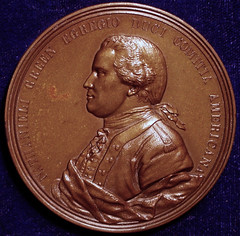

Nathaniel Greene mahogany finish medal
https://forums.collectors.com/discussion/1007285/mahogany-versus-the-yellow-bronze-finish-for-medals-and-the-nathaniel-greene-medal
Mahogany Finish. A deep, dark patina finish which ranges from chocolate brown to red-brown. (The color closely resembles that of mahogany wood, hence the name). It was extensively used by the United States Mint on all its bronze medals in the later half of the 19th century but was phased out (beginning 1900 and ceased by 1910) because it was so labor intensive and time consuming. It was accomplished by a double-heating process known as fire-bronzing. (It is said one could have ordered medals from the Mint in either the dark mahogany or the lighter patina finish during the 10-year transition period at the buyer's option.)
Fire-bronzing predated the highlight-by-oxidizing-and-relieving finishing process, developed by the French in the 1880s, which the U.S. Mint adopted in place of fire-bronzing. (Numismatists called this later finish yellow-bronze). A close approximation of the mahogany color was achieved in 1930 by the Medallic Art Company for the Second Issue of the Society of Medalists, Dionysus, by Paul Manship. It accomplished this dark brown bronze patina with chemicals (ferric nitrate) but this was still not the exact deep mahogany color that results from red lead and fire-bronzing used in the 19th century.
In addition to fire-bronze, fire-bronzing, see also patina, finish and finishing.
Reference:
M37 {1977} Julian, Introduction, p XXXV-XXXVII (35-37).
Looking for the meaning of a numismatic word, or the description of a term? Try the Newman Numismatic Portal's Numismatic Dictionary at: https://nnp.wustl.edu/library/dictionary
Or if you would like a printed copy of the complete Encyclopedia, it is available. There are 1,854 terms, on 678 pages, in The Encyclopedia of Coin and Medal Technology. Even running two a week would require more than 19 years to publish them all. If you would like an advance draft of this vital reference work it may be obtained from the author for your check of $50 sent postpaid. Dick Johnson, 139 Thompson Drive, Torrington, CT 06790.
WILLIAM G. HESSLEIN (1866?-1932?)
 One of six children born of a Jewish family in New York. His father was Samuel A. Hesslein (1831-1904) and his mother Rosalie Hesslein. His father was born in Germany
and moved to America in 1857. His father was a partner in Neuss, Hesslein & Co., formed between 1861 and 1863. His older brother Edgar Joseph Hesslein took over his
father's share of the business after his father death. The family dry goods business was huge and imported and exported goods throughout the United States, South America and
the Middle and Far East.
One of six children born of a Jewish family in New York. His father was Samuel A. Hesslein (1831-1904) and his mother Rosalie Hesslein. His father was born in Germany
and moved to America in 1857. His father was a partner in Neuss, Hesslein & Co., formed between 1861 and 1863. His older brother Edgar Joseph Hesslein took over his
father's share of the business after his father death. The family dry goods business was huge and imported and exported goods throughout the United States, South America and
the Middle and Far East.
He is purported to have been a veteran of the Union Army.
He married Clara M. Hesslein in 1891. A decree of absolute divorced was granted by Judge Giegerich to Clara M. Hesslein from William Hesslein. Soon after his divorce he began to sell coins.
In his coin prices catalogs he prints "Established 1895." He joined the ANA in 1899 and is member no. 158, with his mailing address above the Drug Store formerly owned by William Elliot Woodward (1825-1892) at 101 Tremont Street in the Paddock Building, Boston. Apparently, he became a numismatic dealer and cataloger by 1895 and so it appears bought the remaining W. E. Woodward coin and numismatic stock off his son Harlow.
About 1900-1901 he was cheated out of $40.00 by Edouard Frossard, Jr. He frequently corresponded with the Chapman Brothers beginning with his business at New Haven, Connecticut in 1902.
He became a traveling salesman who sold druggist sundries. He carried coins in a grip-sack from city to city in the eastern United States. He typically wrapped brilliant uncirculated coins in toilet paper as an absorbent to prevent discoloration by oxidation. He consigned coins for Thomas Elder's first auction sale in 1905. His most notable sale was of the late Ralph Barker, about 1906.
Another interesting early auction sale was of the George Rowe collection held on November 6, 1909.
In addition to the Boston office he had a business office in the Malley Building, New Haven, Connecticut, at least from the beginning of 1902 to June 1913.
On May 20, 1913 he won an 1873 $3 Gold piece for $76.00 at the auction held by the United States Coin Company, New York.
"Mr. Hesslein of New Haven, came over to Providence, lately. He reports that the coin business was booming, there never before being quite such a good demand for fine coins."
After June 1913 his main office was above the William Elliot Woodward Drug Store at 101 Tremont Street in the Paddock Building, Boston. From July 1913 to December 1931 he ran weekly advertisements in the Boston Herald.
He claimed to have conducted well over 140 auctions to 1931, which were numbered up to 144. If correct then he held 4 auctions per year on average during the 36 years he was in the coin business. During his final 7 years of business he held nearly 6 auctions per year. However, Adams rightly holds that 70 auctions purportedly conducted between 1916 and 1923 are pure fabrications in the numbering system to look more impressive to his market audience.
He issued 30 fixed price lists.
His last sale was held on December 4-5, 1931 with coins consigned from Charles L. Stuart, G. Arthur Cook et alia. He quietly died shortly after his final coin auction sale. Some believe he did not die at that time but quietly slipped out of sight as a petty crook. Adams has written: "history is cruel to the petty crook. If one robs or extorts on only a modest scale, there are no Boswells and there are no film rights. Such was the fate of William Hesslein; by absconding with but small money, he left no biography behind him . . ."
To read the complete article, see:
HESSLEIN, WILLIAM G. (http://www.numismaticmall.com/numismaticmall-com/hesslein-william-g)

HERITAGE OFFERS DON CHAPMAN U.S. GOLD COLLECTION
Steve Lansdale of Heritage Auctions shared this information about how one of their consignors got started in the hobby. Thanks! -Editor
NASA Gold Medal Starts A Collector's Journey
Heritage Auctions will be offering the Don Chapman Collection as one of the featured collections of coins in the June 2020 Long Beach Auction #1316. While one of these coins is neat enough that I already put in a PR Power about that specific lot, today I learned a great backstory for the collection.
Don Chapman was a programmer for NASA's Apollo missions and received a gold medal from NASA that got him interested in coin collecting. While much of his work was private due to its level of importance, numismatics was a hobby that he could happily share with his family. He began collecting American gold coins and particularly sought out $20 Liberties.
One of the collection's highlights is this 1871-CC double eagle. -Editor
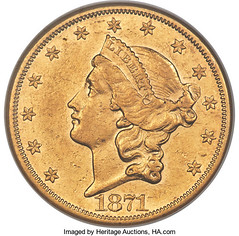
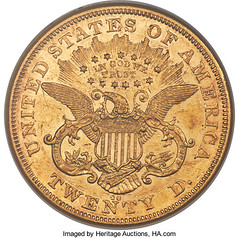
1871-CC $20 AU58 NGC. Variety 1-A. The second 1 in the date is centered over the denticle below. If we were to rule out the famous first-year 1870-CC double eagle as an unobtainable rarity, then the 1871-CC twenty would rightly take its place among the most challenging Carson City issues collectors could ever hope to obtain.
The mintage for the 1871-CC double eagle is disputed. Carson City expert Rusty Goe claims in his 2003 reference, The Mint on Carson Street, that 14,687 coins were struck. The Guide Book reports a total production of 17,387 pieces. Experts are in relative agreement when it comes to the number of survivors -- an estimated 200 to 250 coins. Of those, the vast majority are in VF and XF grades. Doug Winter, who suggests an AU survivorship of 45 to 50 coins, wrote in 2001:
"This is a very scarce date in about Uncirculated and most of the pieces known in this grade range are no better than About Uncirculated-50. The 1871-CC becomes rare in About Uncirculated-55 and it is very rare in About Uncirculated-58. This is an extremely rare coin in Uncirculated with just two or three pieces currently known."
What was true then remains true today. Unlike other Carson City issues from the mid-1870s and 1880s, no vast quantities of the 1871-CC have come out of European vaults over the last two decades. Examples remain major rarities in AU58, and only a handful of coins are known in Mint State. Specifically, NGC reports 18 AU58 grading events and five finer (4/20). The certification totals are almost certainly inflated by resubmissions, so take them with a grain of salt.
To read the complete lot description, see:
1871-CC $20 AU58 NGC. Variety 1-A. The second 1 in...
(https://coins.ha.com/itm/liberty-double-eagles/1871-cc-20-au58-ngc-variety-1-a/p/1316-36010.s)
NUMISMAGRAM MEDAL SELECTIONS: MAY 2020
Jeremy Bostwick at Numismagram sent along some highlights from his most recent addition of new material at the beginning of May. Along with the pieces below are a couple interesting architectural types, two love tokens, two shooting medals (one of which is certainly out of the ordinary), three alluring Swedish medals from the hand of the skilled Erik Lindberg, and some high grade, attractively toned silver medals. Please visit numismagram.com/inventory for all of these new additions. -Editor
Hilde Sperling Wimbledon Silver Award Medal
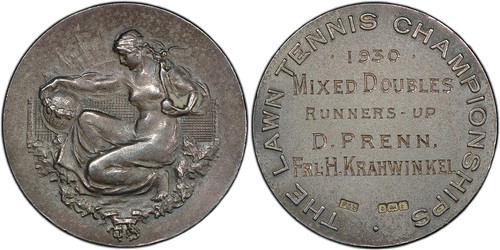
101102 | GREAT BRITAIN & GERMANY. Hilde (Krahwinkel) Sperling silver Award Medal. Engraved and awarded in 1930 for the mixed doubles runners-up at the Wimbledon Championships (37mm, 12h). By Fattorini & Sons. Athena, representing the virtues of athletic competition, kneeling left before tennis net, holding crowning Nike on globus and wrapping laurel wreath around the earth / THE LAWN TENNIS CHAMPIONSHIPS, • 1930 • / MIXED DOUBLES / RUNNERS–UP / D. PRENN, / FRL • H. KRAHWINKEL engraved in five lines. Graded PCGS SP63 Matte. Deeply toned, with some subtle brilliance. An incredibly attractive and interesting medal from one of Germany's greatest female tennis players, second only to Steffi Graf. $2,250.
Likely among the top three female tennis players of the interwar period—along with Helen (Wills) Moody and Suzanne Lenglen—Hilde (Krahwinkel) Sperling was born in Essen, Germany in 1908. During the decade of the 1930's, she was consistently ranked among the top ten, amassing Grand Slam singles victories at the French Open (1935–1937) and a mixed doubles victory at Wimbledon (1933). In her three-peat at Roland Garros, she became the second of just four women to ever perform such a feat, the others being the aforementioned (Wills) Moody along with Monica Seles and Justine Henin. She also had numerous runner-up performances at the Slams, one of which was the event commemorated on this prize medal, where she paired with fellow German Daniel Prenn in their loss to Elizabeth Ryan (United States) and Jack Crawford (Australia) at the Wimbledon mixed doubles championship in 1930. She married Dane Svend Sperling in December 1933 and was inducted posthumously into the International Tennis Hall of Fame in 2013, having passed away in 1981.
Nice - I'd never seen one of these before. -Editor
To read the complete item description, see:
101102 | GREAT BRITAIN & GERMANY. Hilde Sperling silver Wimbledon Award Medal.
(https://www.numismagram.com/product-page/101102)
Battle of the Marne Bronze Medal
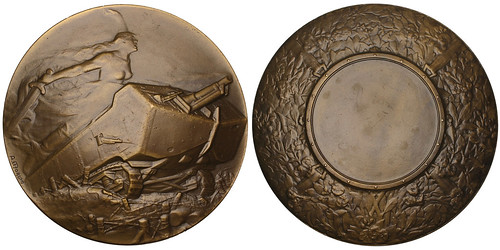
101086 | FRANCE. Battle of the Marne bronze Medal. Issued 1918 (68mm, 142.59 g, 12h). By P.-A. Morlon. Marianne-Victory advancing right, holding sword and guiding a Saint-Chamond tank across the battlefield / Wreath surrounding central field left blank for inscription. Edge: «cornucopia» BRONZE, a few scattered marks. The Art of Devastation 15. Choice Mint State. Alluring bronze surfaces, with a pleasing matte nature. Compare to a similar piece which sold for a total of $408 in April 2020 (Stack's Bowers CCO, lot 30049). $325.
Seldom encountered in numismatics, this type presents a WWI-era tank being guided across the battlefield. First introduced in 1916 by the British at the Battle of the Somme, tanks were quickly adopted by other powers to be used during warfare
Amazing piece; love the obverse - great juxtaposition of soft curves and hard angles. -Editor
To read the complete item description, see:
101086 | FRANCE. Battle of the Marne bronze Medal. (https://www.numismagram.com/product-page/101086)
1970 World Cup Silver Medal
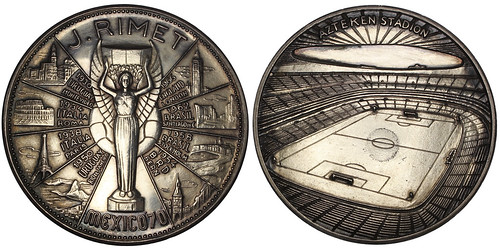
101052 | MEXICO & GERMANY. FIFA World Cup silver Medal. Issued 1970. Commemorating the games and the host country (60mm, 68.83 g, 12h). J RIMET / M?XICO '70, the original World Cup, known then as the Jules Rimet Cup, with views of the civic hosts, along with the winning countries up to that point, listed around / AZTEKEN STADION, interior view of the Estadio Azteca, set for a soccer match. Edge: 1000. Choice About Uncirculated. Highly lustrous and brilliant, with some lightly scattered hairlines. $175.
Fourteen teams, along with defending champs England and host country Mexico, were involved in the final stage of the tournament. From among them, Uruguay, West Germany, Italy, and Brazil made it to the final four, with the latter two meeting in the championship match. In this contest, Pelé and Brazil bested their Italian counterparts easily by a score of 4-1 at Estadio Azteca before the enormous crowd of 107,412 spectators. This victory represented Brazil's third World Cup which, per rules at the time, allowed them to keep the initial Jules Rimet trophy, thus necessitating a new trophy to be created for the next World Cup in 1974. Sadly, this cup was stolen in Rio de Janeiro in 1983, never to be seen again and likely melted by the looters.
Busy obverse, empty reverse, but still a nice piece. -Editor
To read the complete item description, see:
101052 | MEXICO & GERMANY. FIFA World Cup silver Medal. (https://www.numismagram.com/product-page/101052)
Vanatu Bronze Medal

101006 | VANUATU, FRANCE & GREAT BRITAIN. Bronze Medal. Issued 1956. Commemorating the 50th anniversary of the Condominium of the New Hebrides (68mm, 159.76 g, 12h). By G. Guiraud. QUEIROZ BOUGAINVILLE COOK, carved native totem / CONDOMINIUM FRANCO–BRITANNIQUE DES NOUVELLES HEBRIDES, outline of the archipelago set over beach scene with anchored ship at a distance. Edge: «cornucopia» BRONZE. Ruedas, Ocean Pacifique 57. Gem Mint State. Warm brown surfaces. Very rare and interesting. $325.
An archipelago located in the south Pacific to the east of Australia and the north of New Zealand, Vanuatu first had contact with Europeans in the early 17th century. Over a century and a half would pass until more contact came, first by the French under Louis-Antoine de Bougainville in 1768, then by the British just six years later under James Cook, who gave them their long-standing name—New Hebrides. A century later, with both France and Great Britain claiming the islands, a pact was made whereby the archipelago would be jointly governed as an Anglo-French condominium. Independence from the pair was only gained in 1980, with the name changing from New Hebrides to the more indigenous c, meaning "home-stand" in several Austronesian languages. The ninth season of Survivor, airing in the fall of 2004, was filmed there, styled as Survivor: Vanuatu — Islands of Fire.
Unusual piece. I wish I could be on that beach right now. -Editor
To read the complete item description, see:
101006 | VANUATU, FRANCE & GREAT BRITAIN. Bronze Medal. (https://www.numismagram.com/product-page/101006)

ARCHIVES INTERNATIONAL SALE #59 SELECTIONS
Here are some items that caught my eye in the upcoming Archives International sale. -Editor
From the email announcement by Bob Schwartz:
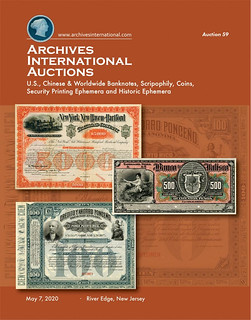 "I would like to dedicate Auction 59 to all of the medical workers, essential workers and others who have devoted their time, their resources and risked their lives
in the ongoing fight to defeat COVID-19. During these dark and unprecedented times, which are affecting everyone to varying degrees. The power of our commitment to work together
towards a shared goal will ensure a stronger, better future. Stay safe, stay well.
"I would like to dedicate Auction 59 to all of the medical workers, essential workers and others who have devoted their time, their resources and risked their lives
in the ongoing fight to defeat COVID-19. During these dark and unprecedented times, which are affecting everyone to varying degrees. The power of our commitment to work together
towards a shared goal will ensure a stronger, better future. Stay safe, stay well.
"The Team at Archives International is committed to taking every safety precaution as well: We have reduced the number of team members in the office at any one time and are working remotely wherever possible. As always, we are available to you via phone or email literally anytime.
"Your participation in the auction is appreciated and can be conducted safely in the comfort of your own home. We hope it will offer an enjoyable distraction from your current confined routine as well as allow you to pursue your collecting passions."
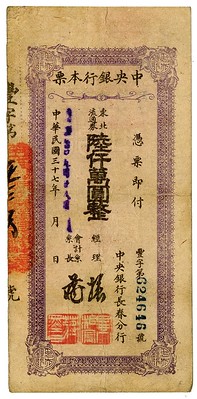
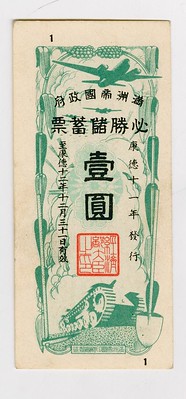
Lots 31 and 33
Lot 31: 1948 China 10 Gold Yuan
China, 60,000,000 Yuan - 10 Gold Yuan, P-449K, Issued, purple with red overprints, S/N 624646, Fine condition.
To read the complete lot description, see:
Central Bank of China, 1948 "Changchung"
Branch Gold Chin Yuan Issue. (https://auction.archivesinternational.com/Central-Bank-of-China-1948-Changchung-Branch-Gold-Chin-Yuan-Issue_i36910986)
Lot 33: 1944 Manchukuo Government Military Saving Bond
China. Issued 1 Yuan, 1944, P-unlisted, airplanes at top and tank at bottom, text on back, VF-XF or better. Unusual circulating bond.
To read the complete lot description, see:
Manchukuo Government Military Saving Bond. 1944. Issued
Note. (https://auction.archivesinternational.com/Manchukuo-Government-Military-Saving-Bond-1944-Issued-Note_i36910993)
Lot 108: Germany Scholven POW Camp Notes
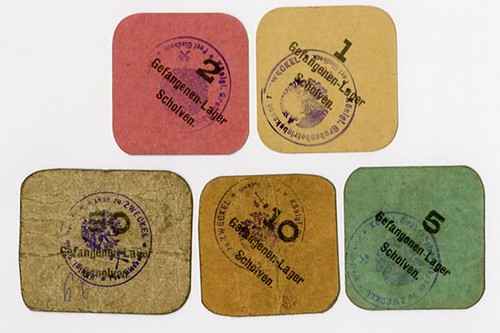
Germany. Scholven POW Camp. Lot includes 1 Mark, 2 Mark, 5 Mark, 10 Mark, & 50 Mark, all with validation stamps. Fine to XF. (5)
The sale includes a number of group lots of Prisoner of War camp notes. -Editor
To read the complete lot description, see:
Scholven POW Camp. ND (1914-1918). Lot of 5 Issued Notes.
(https://auction.archivesinternational.com/Scholven-POW-Camp-ND-1914-1918-Lot-of-5-Issued-Notes_i36911063)
Lot 116: 1918 Germany Steinburg District Notes

Germany. Steinburg District. Lot includes 1 Mark, 2 Mark, 5 Mark, 10 Mark, 20 Mark, & 50 Mark. VF to XF. (6)
To read the complete lot description, see:
Steinburg District. 1918. Lot of 6 Issued Notes.
(https://auction.archivesinternational.com/Steinburg-District-1918-Lot-of-6-Issued-Notes_i36911071)
Lot 133: 1994 Italy 100,000 Lire Replacement Note
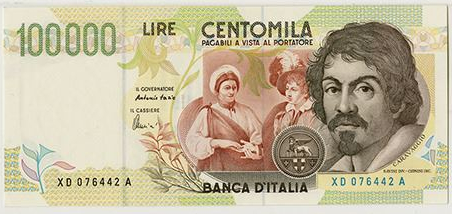
Italy, 100,000 Lire, P-117b*, Issued Replacement Star note, Caravaggio at right, S/N XD 076442A, PMG graded Gem Uncirculated 66 EPQ. Only one other Replacement note has been offered at auction over the last 7 years, this example in far higher grade.
Nice modern rarity. -Editor
To read the complete lot description, see:
Banca d'Italia, 1994 Issue Replacement / Star Note.
(https://auction.archivesinternational.com/Banca-d-Italia-1994-Issue-Replacement-Star-Note_i36911088)
Lot 243: 1902 Citizens National Bank of Peru $5
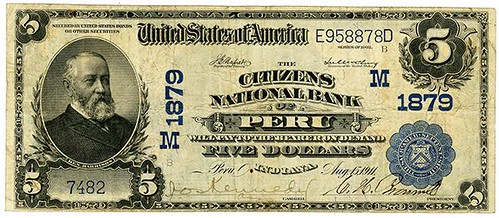
Peru, IN. $5 PB, Ch# 1879, Napier | McClung signatures, S/N 7482-E598878D, VF condition. 23 large size notes known on this bank with 10 $5 PB's in the census.
I never got into collecting National Bank Notes, but individual notes can be quite rare and challenging to locate. -Editor
To read the complete lot description, see:
Citizens National Bank of Peru, 1902 PB, $5, Ch#
M 1879 National Banknote. (https://auction.archivesinternational.com/Citizens-National-Bank-of-Peru-1902-PB-5-Ch-M-1879-National-Banknote_i36911198)
Lot 251: 1933 Pittsburgh Clearing House Certificate

Pittsburgh, PA. ND (1933), $20 Proof Depression Scrip Note, Green, Ornate border, no underprint, POC's, Purple CANCELLED overprinted on top probably referring to the printing plate for the note being cancelled. AU to Uncirculated. Republic BNC.
I grew up in Pittsburgh and collected Pittsburgh obsolete currency for many years, including the 1907 Clearing House certificates. I don't think I had one of these Depression-era notes. -Editor
To read the complete lot description, see:
Pittsburgh Clearing House Certificate, 1933
Proof Depression Scrip Note. (https://auction.archivesinternational.com/Pittsburgh-Clearing-House-Certificate-1933-Proof-Depression-Scrip-Note_i36911206)
Lot 667: 1891 Mt. Penn Gravity Railroad Co. Bond
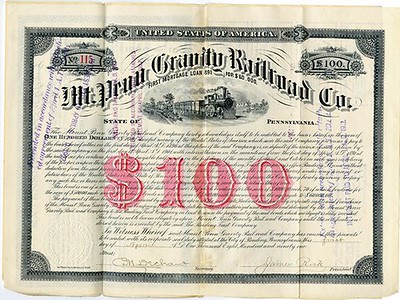
Reading, PA. $100. I/U 1st Mortgage 6% Loan of 1891 for $60,000 Coupon Bond, Black with red "$100" underprint, locomotive L-R. S/N 115, VF condition, also included are 3 Extension Contracts dated 1902; 1912 and 1922. The Station was located in Mineral Springs Park, within easy access by street cars from all parts of the city and railroad stations. A mountain climb behind a powerful engine, two and a half miles to the summit of Mt. Penn, 1200 feet above the sea-the Black Spot. A lofty solid Stone Tower on the mountain top, from which appears a magnificent view of the city of Reading, the broad and fertile Schuylkill and Lebanon Valleys, the distant ranges and peaks of the Blue Mountains, to the horizion-30 miles in every direction. Large pavilions for shelter and rest and a well-conducted restaurant. From the summit a rapid flight BY GRAVITY, 5 miles, over a road of light grades, through groves, vineyards, and mountain farms to the starting-point. Along the road, attractive summer resorts and picnic grounds. First time seen by cataloger. Rare and attractive.
There are quite a number of interesting stock and bond certificates in the sale, including many tech favorites such as Microsoft, Yahoo and eBay. -Editor
To read the complete lot description, see:
Mt. Penn Gravity Railroad Co., 1891 I/U Coupon Bond.
(https://auction.archivesinternational.com/Mt-Penn-Gravity-Railroad-Co-1891-I-U-Coupon-Bond_i36911622)
THE BOOK BAZARRE
CARES ACT TREASURY CHECK SECURITY FEATURES
Recently we discussed the potential collectibility of the U.S. Government's coronavirus stimulus checks. Kavan Ratnatunga forwarded this U.S. Secret Service publication discussing the security features found on genuine checks. Thanks - now we at least know one one of these looks like. -Editor

U.S. SECRET SERVICE IN PARTNERSHIP WITH THE U.S. DEPARTMENT OF THE TREASURY LAUNCH - KNOW YOUR U.S. TREASURY CHECK CAMPAIGN
The Secret Service in partnership with the U.S. Department of the Treasury is leading the charge to bring awareness to citizens, retailers and financial institutions on how to protect themselves from becoming a victim of easy to detect counterfeit U.S. Treasury Checks. According to the Internal Revenue Service (IRS), paper U.S. Treasury checks from the $2 trillion dollar Coronavirus Aid, Relief and Economic Security Act (CARES Act) will be mailed and issued to millions of Americans beginning late April, 2020. With the implementation of the CARES Act, comes opportunities for criminal activity, like check fraud.
The Secret Service and the U.S. Department of the Treasury want to inform citizens and consumers nationwide on ways to protect themselves during these times. This announcement contains information that consumers and financial institutions can use to identify counterfeit U.S Treasury checks by knowing what to look for and where to look. Quick Tips / Genuine Security Features:
• Treasury Seal – A new seal to the right of the Statue of Liberty. It should say "Bureau of the Fiscal Service," and has replaced the old seal that said "Financial Management Service."
• Bleeding Ink – the seal to the right of the Statue of Liberty when moisture is applied to the black ink will "run" and turn red.
• Watermark – All U.S. Treasury checks are printed on watermark paper. The watermark reads "U.S. TREASURY," and is seen from both front and back when held up to a light source.
• Ultraviolet Overprinting – A protective ultraviolet (UV) pattern is invisible to the naked eye, consisting of lines of "FMS" bracketed by the FMS seal on the left and the U.S. Seal (eagle) on the right. As of 2013, a new ultraviolet patter was introduced into the check that says "FISCALSERVICE". Either one of these UV patterns maybe be seen.
• Microprinting – is located on the back of the check with the words "USAUSAUSA."
• Economic Impact Payment: The Economic Impact Payment checks will have the following information located on the lower right side of the Statue of Liberty: "Economic Impact Payment President Donald J. Trump"
I was unaware of the "Bleeding Ink" feature. Has anyone seen this in action? See the next article in this issue for more. -Editor
To read the complete press release, see:
https://www.secretservice.gov/data/press/releases/2020/20-APR/Check-Security-Features-for-Economic-Impact-Payments.pdf
To read the earlier E-Sylum article, see:
WILL CORONAVIRUS STIMULUS CHECKS BE COLLECTIBLE? (https://www.coinbooks.org/v23/esylum_v23n16a33.html)
BLEEDING INK SECURITY FEATURE
 In the previous article on security features found on genuine U.S. government checks, I learned about "bleeding ink."
In the previous article on security features found on genuine U.S. government checks, I learned about "bleeding ink."
One provider describes it as follows: "Bleeding ink prints in black but when exposed to any aqueous solution it will produce a red stain. Authenticity of a document can easily be tested without the use of any special agents. User can just wet a finger and run it across the ink to instantly see the affect of the bleeding ink. This ink is only available for use on dry offset printing."
If it doesn't work with intaglio printing, that would explain why the feature is found on U.S. government checks but not banknotes. I found one patent for "bleeding ink", but there may be others. Here's the abstract. -Editor
Bleeding ink for printing security documents
A bleeding or fugitive printing ink is disclosed and claimed which can be printed by the method of dry or wet offset or letterpress. This ink allows, when printed on security documents and dried, to prevent attempts of forgery or counterfeit in that the ink contains at least one dyestuff which is sensitive to organic solvents and other chemical reagents. The ink, when printed, forms a solid, polymerized or cross-linked binder matrix on the surface of the document when the printings are submitted to energy radiation, or by an oxypolymerization reaction. This matrix is formed near immediately, in the case of oxypolymerization within 24 hours, in contrast to conventional bleeding printing inks whose matrixes do not really dry and remain liquid in the interstices of the substrate.
I reached out to E-Sylum regular and former Bureau of Engraving and Printing Director Bob Leuver. Thanks. -Editor
Bob writes:
"The security features exist in the arsenal of both the Secret Service and the BEP. I am aware of the security features announced for the Covid-19 IRS payment checks. Rather awesome. However, I do not know which agency is responsible for the research and implementation of the security features, that is, Secret Service, BEP, or Bureau of Fiscal Service. Nor do I know which agency or company printed the checks (stock), the BEP, Government Printing Office or an outside company. I would think that the development use and care of these security features is rather tightly held."
To read the complete patent, see:
United States Patent 6,306,929 Bleeding ink for printing security documents
(http://www.freepatentsonline.com/6306929.pdf )
For more on security inks, see:
Security Inks What types of security inks are there?
(http://www.securitylitho.com/Pages/Glossary/Security%20Inks.html)
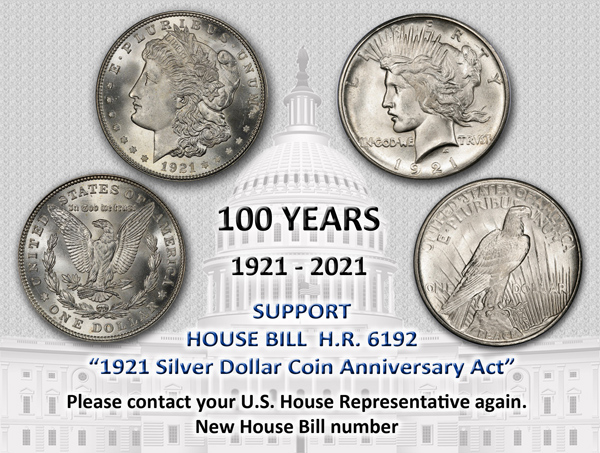
DIRTY MONEY PILING UP IN L.A.
Harvey Stack passed along this article about how the coronavirus is crippling international money laundering along with the rest of the economy. Thanks. -Editor
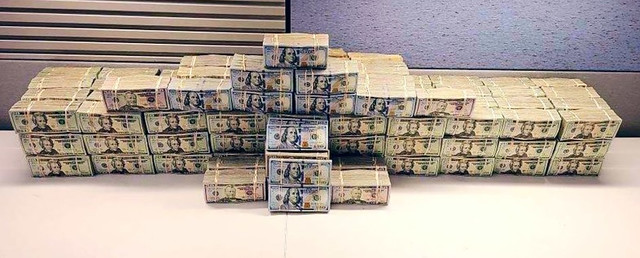
Dirty money is piling up in Los Angeles. In the last three weeks, federal agents made three seizures that each netted more than $1 million in suspected drug proceeds.
The reason, according to the city's top drug enforcement official: The coronavirus pandemic has slowed trade-based money laundering systems that drug trafficking groups use to repatriate profits and move Chinese capital into Southern California.
With storefronts closed, supply chains in disarray and the global economy in peril, these complex schemes are hobbled and cash is backing up in Los Angeles, Bill Bodner, special agent in charge of the Drug Enforcement Administration's Los Angeles field division, said in an interview.
The recent million-dollar interceptions were reminiscent of seizures the DEA made before drug traffickers embraced trade-based money laundering, said Bodner, a 28-year agent.
The shuttering of nonessential businesses has made a "tremendous impact" on a money laundering system dubbed the black market peso exchange, he said. In the fashion district in downtown Los Angeles — the exchange's epicenter — drug trafficking groups from throughout the country use wholesalers to remit profits to Mexico, according to cases filed in federal courts in Los Angeles and elsewhere.
Recently, with storefronts closed and agents seizing millions in cash packaged for transport, it appears drug trafficking groups are resorting to older, riskier ways of repatriating profits, Bodner said.
To read the complete article, see:
Dirty money piling up in L.A. as coronavirus cripples international
money laundering (https://www.latimes.com/california/story/2020-04-29/coronavirus-slows-money-laundering-to-a-crawl)
LOOSE CHANGE: MAY 3, 2020
Here are some additional items in the media this week that may be of interest. -Editor
Coins of Medieval Hungary: Part I
Mike Markowitz published on CoinWeek the first part of a series on the medieval royal coinage of Hungary. He told me, "I know many Hungarian Americans who collect, and the history is right out of "Game of Thrones" (without actual dragons)." -Editor
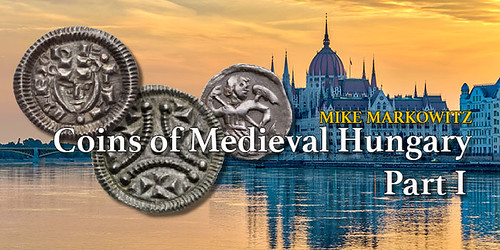
ABOUT THE YEAR 895, THE MAGYARS, a federation of nomadic tribes whose origin was in the distant forests of Siberia, crossed the Carpathian Mountains led by a chieftain named Árpád (c. 845-907), and occupied the wide, fertile Danubian basin. Known to the Romans as "Pannonia", this region had seen the rise and fall of the Huns, the Goths, the Avars, and others.
Magyar warriors were horse archers, a skill that takes years of training and constant practice to master. They were valued as allies in the wars of the Franks and the Byzantines. During the 10th century they became fearsome raiders, looting and pillaging across much of Europe. They abandoned their predatory ways following a crushing defeat in 955 by the armored knights of the German emperor Otto "the Great" (ruled 936-973) at Lechfeld in Bavaria.
Few medieval coins would win a numismatic beauty contest, but their stories give us insight into the brutal "game of thrones" that characterized this turbulent era.
To read the complete article, see:
Coins of Medieval Hungary: Part I
(https://coinweek.com/world-coins/coins-of-medieval-hungary-part-i/)
One Numismatist's Experience With Computers
Ron Guth's latest blog post is a walk down computer memory lane. -Editor
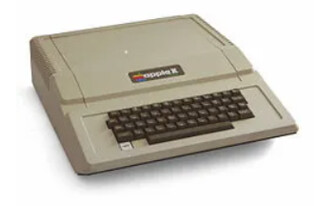 Numismatists rely heavily on computers and computer programs to help track down and process information in a variety of ways. Some of the most important computing tools
used today are word processors, database managers, desktop publishing, webpage editors, spreadsheets, image processors, and data storage. While computers and computing tools are
ubiquitous today, there was a time – not so long ago – when these tools were scarce or non-existent.
Numismatists rely heavily on computers and computer programs to help track down and process information in a variety of ways. Some of the most important computing tools
used today are word processors, database managers, desktop publishing, webpage editors, spreadsheets, image processors, and data storage. While computers and computing tools are
ubiquitous today, there was a time – not so long ago – when these tools were scarce or non-existent.
This blog entry is a trip down memory lane as I recall my experiences with computers over the years.
To read the complete article, see:
One Numismatist's Experience With Computers
(https://numismaticdetectives.com/blog/f/a-numismatist%E2%80%99s-experience-with-computers)
Community Currencies
Dick Hanscom passed along this BBC News article on community currencies. Thanks. -Editor
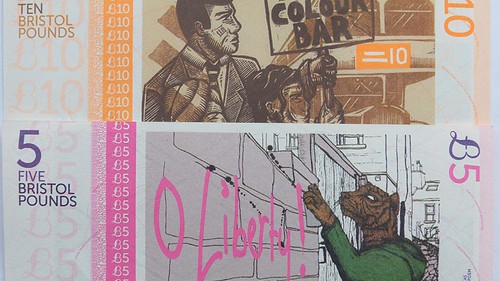
What's a community currency? It's a special, local currency that can only be used within a certain locale at shops or other businesses that have signed up to accept it as an alternative to the official, national currency, with the goal of encouraging spending in the local economy. This can either encompass a whole town, or in the case of a currency like the Brixton Pound, just one London neighbourhood, and can be bought at a rate equivalent to the national British pound. There are thousands of community currencies in the world and the concept has been around for decades, and in the past couple of years, they're becoming more popular as more have become digital.
Community currencies are seen by proponents as an innovative tool to help local trade flourish against the trend to globalisation. Other benefits can include providing a method for people without access to paid employment to earn 'money' through charitable or other community work, as well as providing a medium for a specific town or region to express its individual identity in a way national currencies do not. But community currencies have yet to really infiltrate the mainstream – sometimes stymied by a naïve attitude to running costs, or failure to provide digital forms that chime more with modern ways of spending. Now, however, various currencies are tackling these issues in different ways worldwide.
To read the complete article, see:
Are community currencies a better way to shop?
(https://www.bbc.com/worklife/article/20200427-how-community-currencies-help-keep-businesses-afloat)
Portraits of Franklin & Washington
The faces of George Washington and Benjamin Franklin are universally familiar in part because of their use on U.S. coins and currency. The Delancey Place blog published an excerpt this week from the book Franklin & Washington by Edward J. Larson. Here's an excerpt of the excerpt! -Editor
 "These images adorn America's two most widely circulated banknotes: Stuart's 1796 Athenaeum portrait of Washington (flipped to turn left) on the ubiquitous
American one-dollar bill and Duplessis's 1785 painting of Franklin on the widely hoarded hundred. Together, they account for more than three-fifths of all U.S. banknotes in
circulation, with 'Franklins' constituting some 80 percent of the total value of all American paper money.
"These images adorn America's two most widely circulated banknotes: Stuart's 1796 Athenaeum portrait of Washington (flipped to turn left) on the ubiquitous
American one-dollar bill and Duplessis's 1785 painting of Franklin on the widely hoarded hundred. Together, they account for more than three-fifths of all U.S. banknotes in
circulation, with 'Franklins' constituting some 80 percent of the total value of all American paper money.
"Franklin's portrait expands beyond the bill's borders -- his expressive face looking fleshy and open. Clearly aged, Franklin nevertheless appears vibrant and alive. 'He ... possesses an activity of mind equal to a youth of 25,' a fellow delegate said of the eighty-one-year-old Franklin at the Constitutional Convention, two years after the picture was painted.
"Washington, in contrast, glares out from a tight central oval on the one-dollar bill, his craggy, colorless visage looking like a plaster mask animated only by those intense eyes, which Stuart painted as bluer than they really were. Once told that his expression showed emotion, Washington shot back, 'You are wrong. My countenance never yet betrayed my feelings!'
Stuart saw something in that face, however. 'All his features,' the painter commented, 'were indicative of the strongest and most ungovernable passions.' Yet Washington governed them with a granite, tight-lipped self-control that made him the stoic father figure for a nation that adopted Franklin as its favorite uncle. Together, they midwifed a republic.
To read the complete article, see:
PAINTINGS OF WASHINGTON AND FRANKLIN -- 4/27/20 (https://delanceyplace.com/view-archives.php?p=4086)

FINALLY THERE'S TIME FOR YOUR BOOKS
On the NBS Facebook page, Tom Fort posted a link to this New York Times article on how to organize one's library. -Editor
 Looking to make the most of time spent stuck at home, many of us are turning to books.
Looking to make the most of time spent stuck at home, many of us are turning to books.
And with good reason: Reading a new novel or a classic you've been meaning to get to for years — or even experimenting with recipes you've never tried in an old cookbook — is one of the few reliable ways to escape the onslaught of pandemic-related news.
But how much thought have you given to the way you store your books? Even if your collection seems like a mountainous, unruly mess, it can add appeal to your home — provided you display it well.
Books "tell a story about who the homeowner is," said Nina Freudenberger, the owner of the design firm Haus Interior in Los Angeles, and the author of "Bibliostyle: How We Live at Home with Books."
"Books tell us about what someone was interested in, what their passions are, what their beliefs are and what kind of person they hope to be," Ms. Freudenberger said. "Homes without books have no soul."
Choose an Organizational System
To help make sense of your collection and keep it organized over time, commit to a system — any system — for putting your books in some kind of order.
"Organization is key," said Robert Novogratz, who, with his wife, Cortney, runs the Novogratz, a bicoastal design firm that recently introduced the book "Novogratz Design Fix: Chic and Stylish Tips for Every Decorating Scenario."
But different people have very different preferences.
Many avid book collectors, Mr. Novogratz said, are "old-school Dewey Decimal kind of people," who prefer organizing books by topic or author so they know exactly where to find each and every volume.
Others prefer organizing books in a way that delivers a graphic punch. Although purists may blanch at the suggestion, one method that has increased in popularity in recent years is grouping books by the color of the spine to create a rainbow across the bookcase.
Can you see me blanching? I imagine most numismatic bibliophiles are like me, organizing their libraries by subject. But there are other ways of doing it that have merit. When I visited Frank and Laurese Katen I was surprised to see that the library was arranged alphabetically by author. That system can be useful since every book has one primary author or editor, but many books cover more than one subject. Which one should you file it under? More often the question becomes which subject did I file that one under? This week I wanted to check something in David Lange's books on coin albums, but I just couldn't find where I put them - some books are in a category all their own. -Editor
To read the complete article, see:
Finally There's Time to Read (or at Least Organize Your Books)
(https://www.nytimes.com/2020/04/28/realestate/organize-books.html)
Scott Miller forwarded this BBC News article, asking, "Isn't this how books are supposed to be shelved?" -Editor

A well-meaning cleaner who took the opportunity to give a locked-down library a thorough clean re-shelved all of its books - in size order.
Staff at Newmarket Library, Suffolk, discovered the sloping tomes after the building underwent a deep clean.
James Powell, of Suffolk Libraries, said staff "saw the funny side" but it would take a "bit of time" to correct.
"It looks like libraries will be closed for a while so we'll have plenty of time to sort the books out", he said.
"The cleaner is lovely and does a great job in the library. It was an honest mistake and just one of those things so we would never want her to feel bad about it," he added.
To read the complete article, see:
Coronavirus: Library books rearranged in size order by cleaner
(https://www.bbc.com/news/uk-england-suffolk-52412655)
THE LIBRARY OF COIN, IOWA
A reader submitted this photo essay on a different type of Coin Library. Thanks! -Editor

I thought maybe the E-Sylum readers would get a kick of this photo of the library in Coin, Iowa.
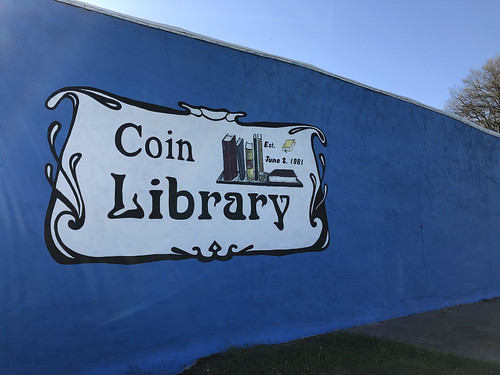
The town is in the extreme southwest corner of the state. Founded around 1880 as a railroad stop with 800 citizens, it has gone steadily downhill ever since. One hundred and forty years later, fewer than 200 people still call Coin home. With an average income of only $16,000, I can see why.

This is the Gold Coin Saloon, now closed. I asked several people how the town got its name; no one knew. But it has a Crook Street and a Church Street (parallel not intersecting), as well as both a Main Street and Broadway. It was out of my way to visit (heck its out of everyone's way to visit) but it was an enjoyable side jaunt on a quasi-numismatic mission.
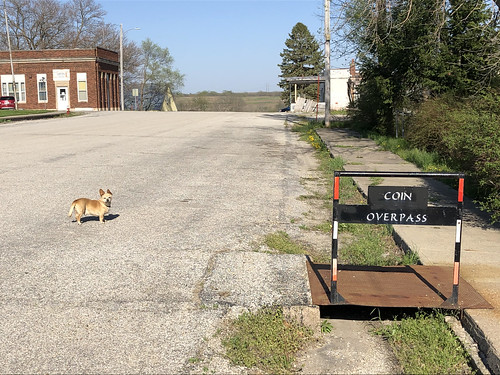
FEATURED WEB SITE: SECESSIONIST MEDALS
This week's Featured Web Site is secessionistmedals.com.WHAT ARE "SECESSIONIST MEDALS"?
In the purest sense, secessionist medals are cast art medals produced between 1905-1925 in the Central European countries of Germany and Austria-Hungary.
OUR PURPOSE AND FORUM GOAL
Our intent is to have a serious clearinghouse for information sharing and research regarding secessionist medalists and their work. We are a small group of collectors and
researchers spread worldwide that now have a venue to discuss this little known art medal collecting area.
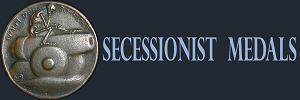
https://secessionistmedals.com/

